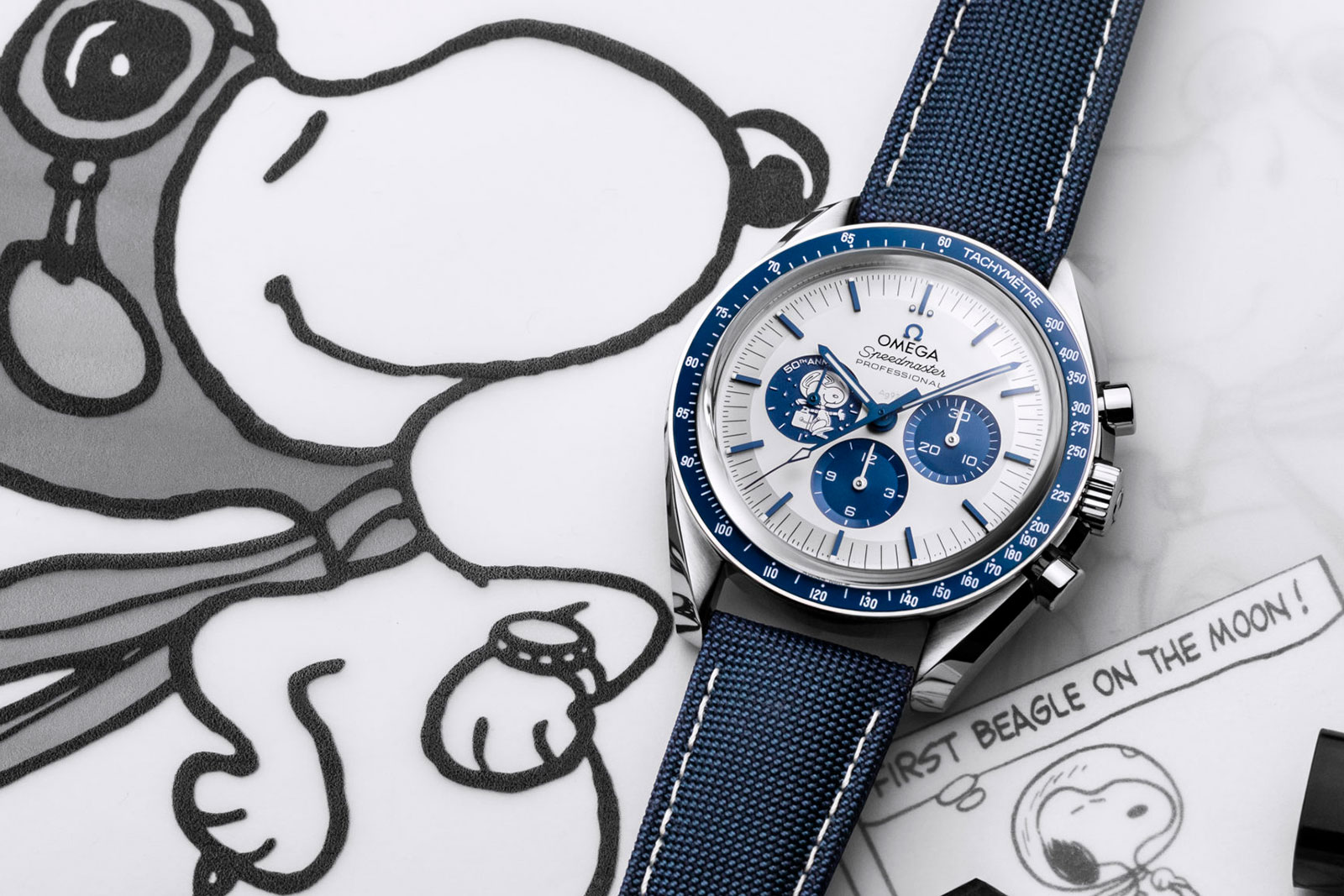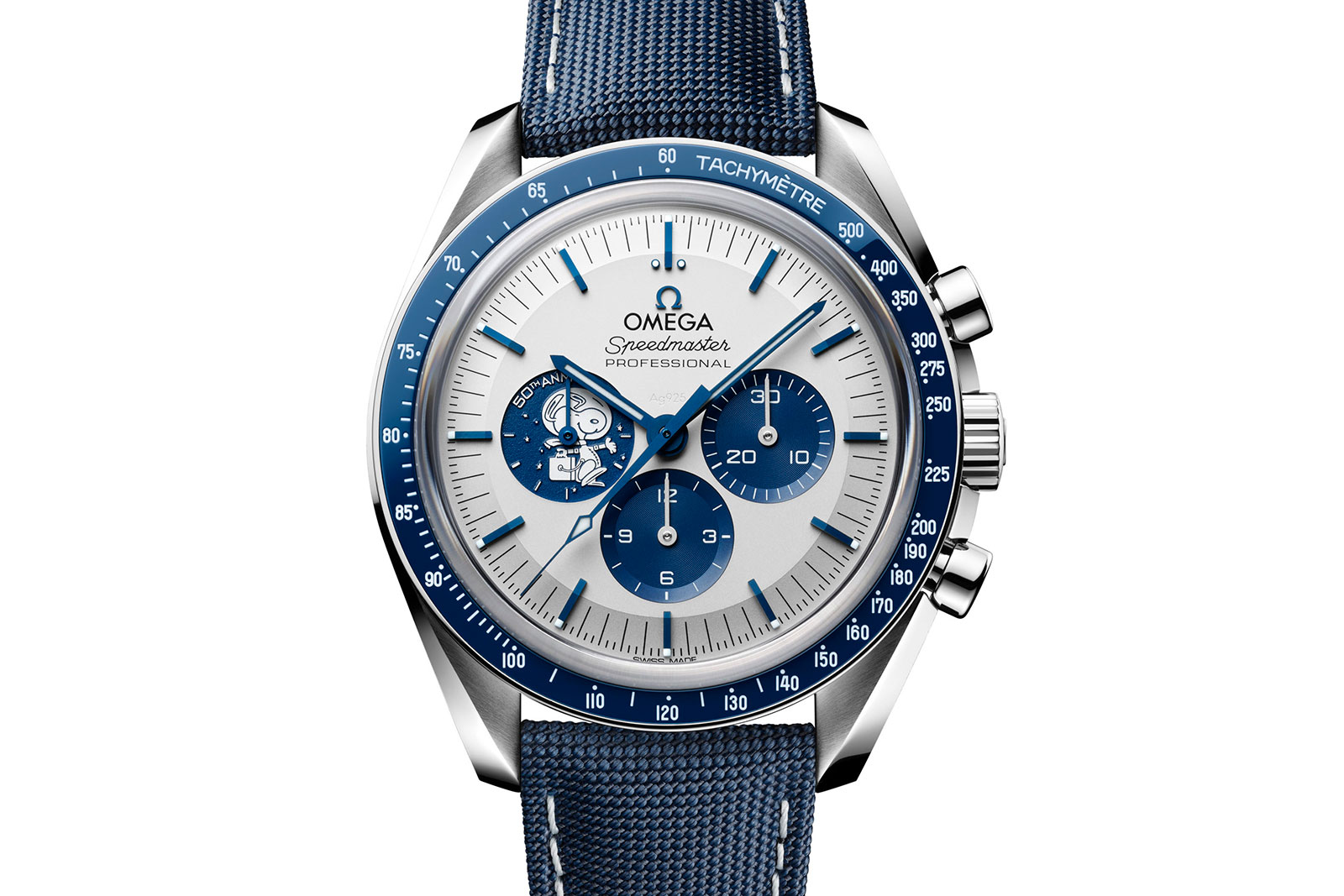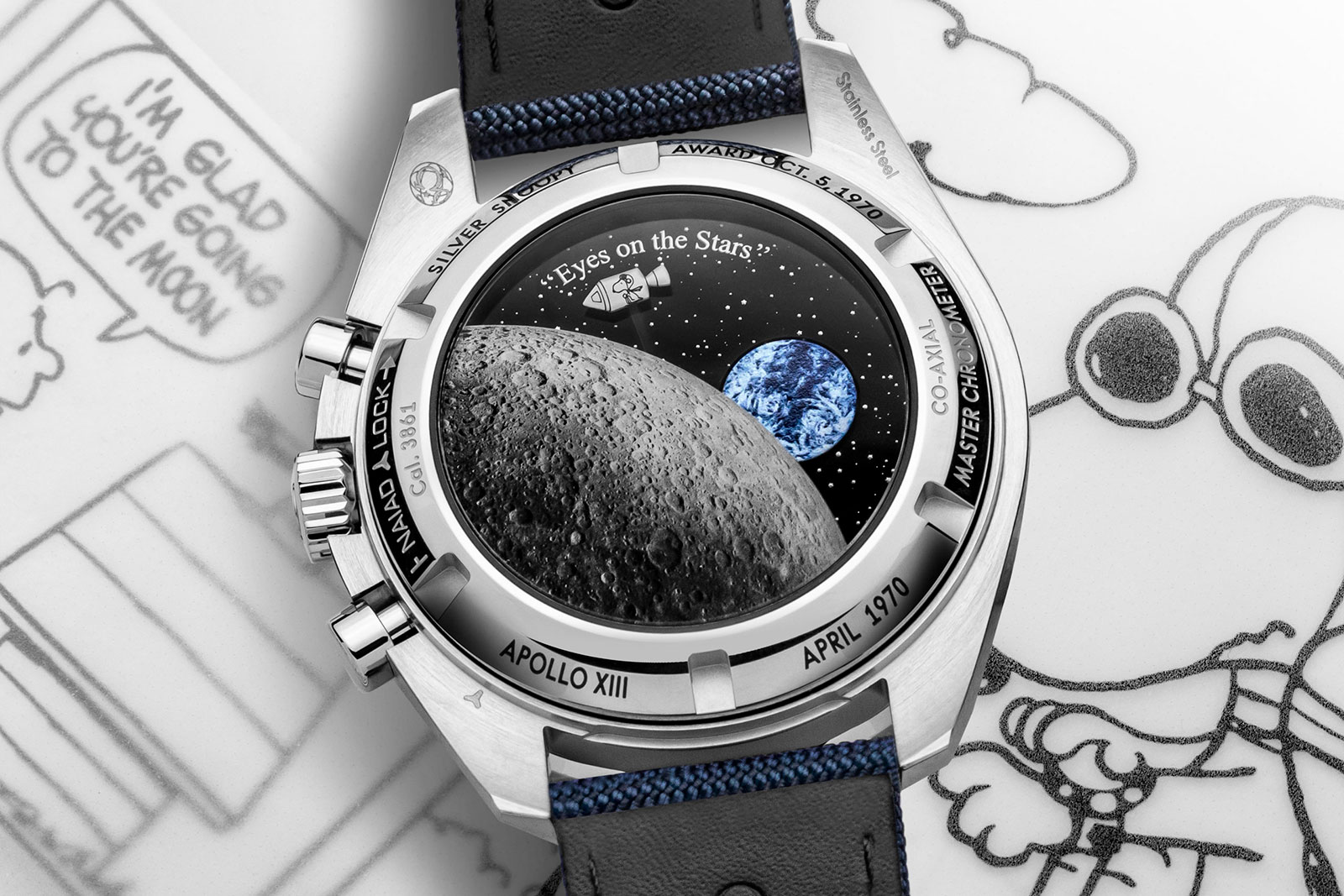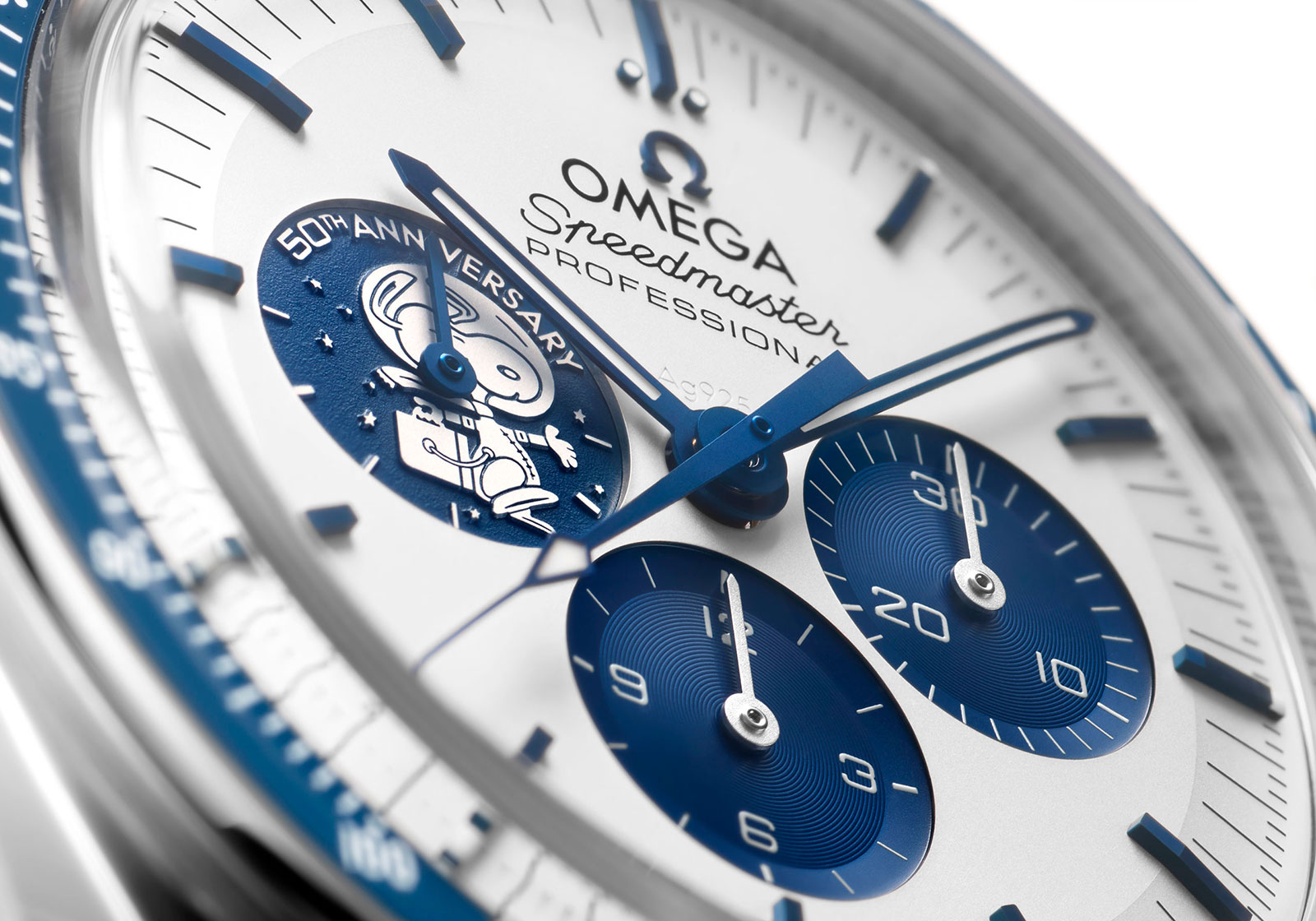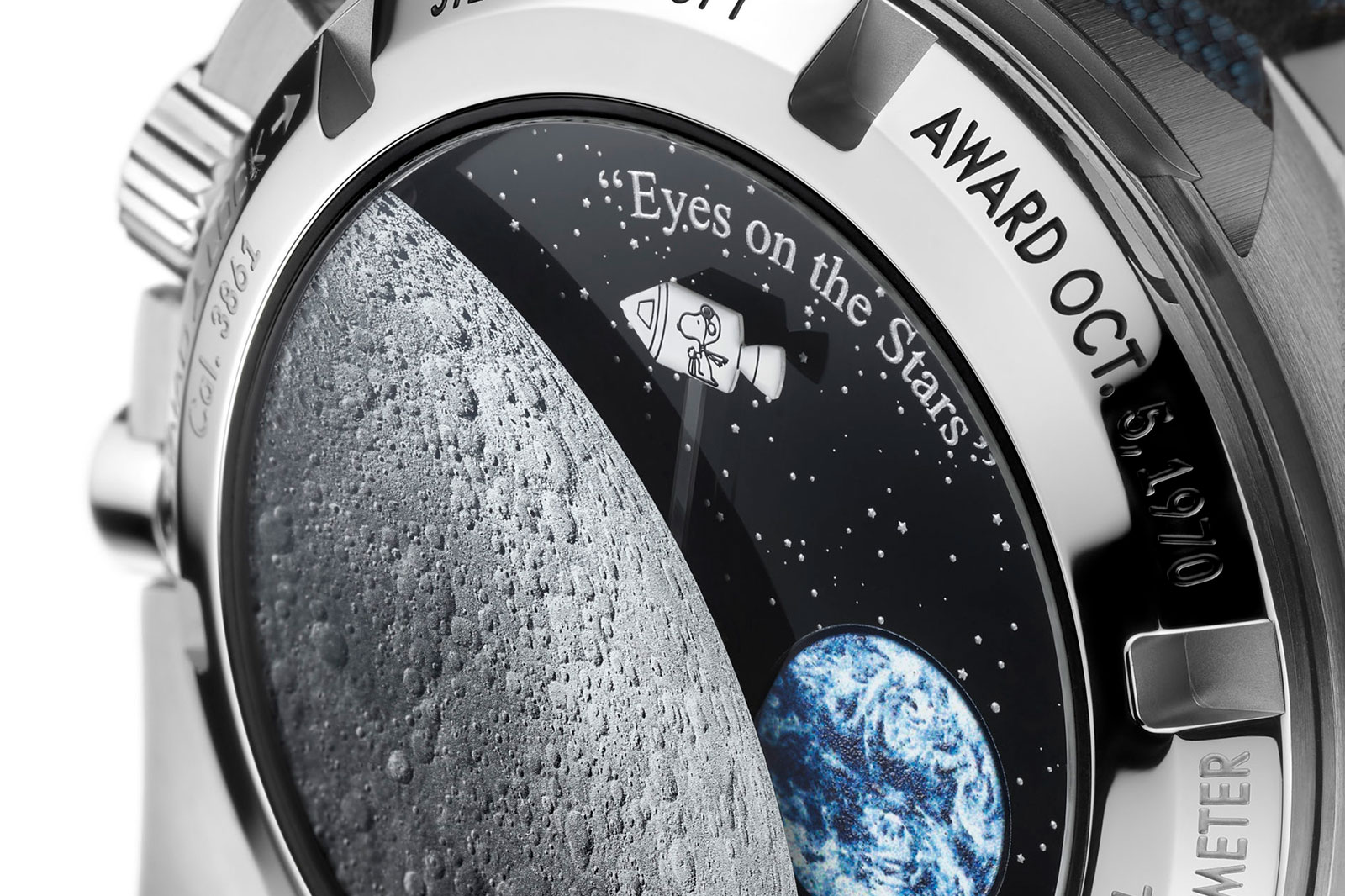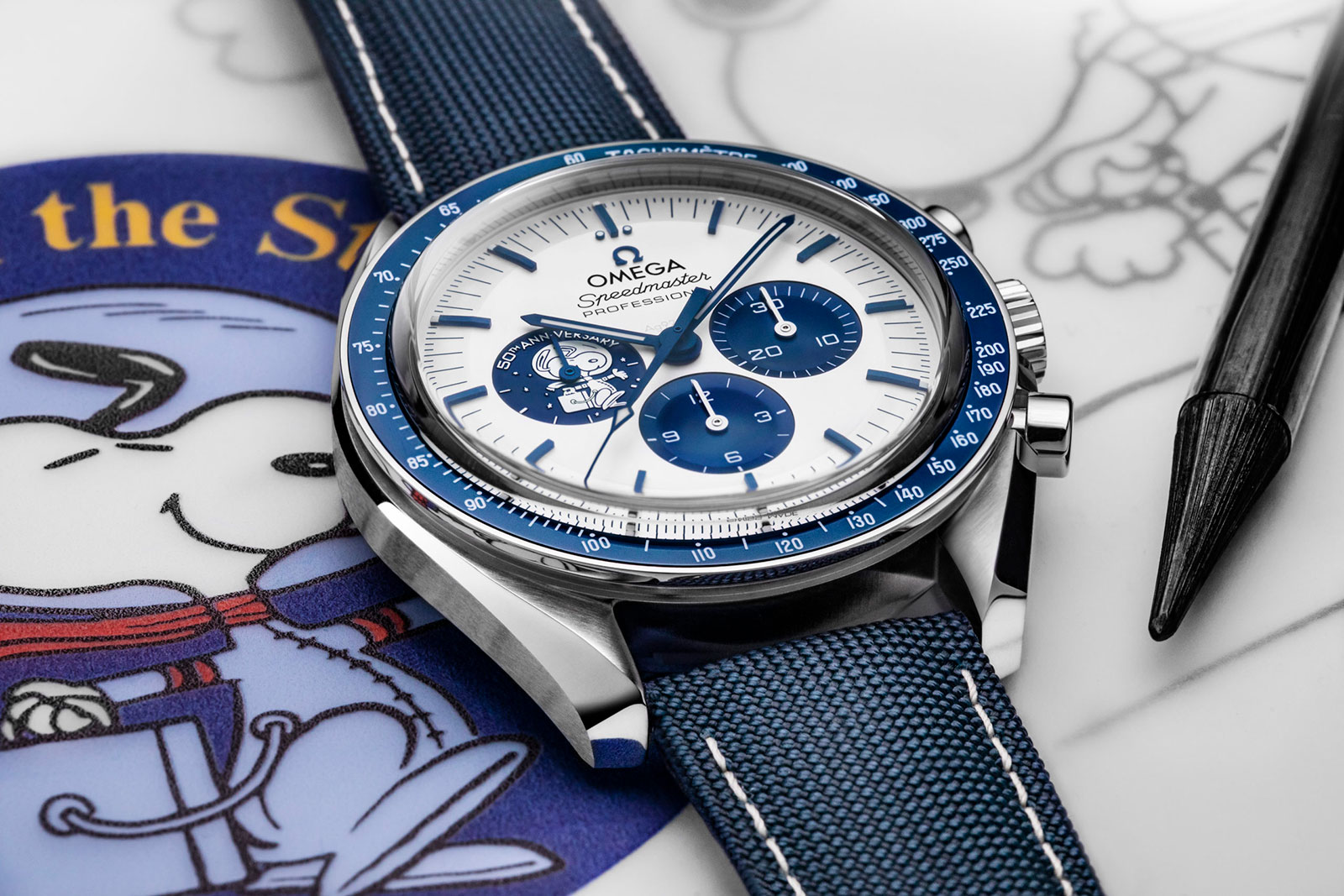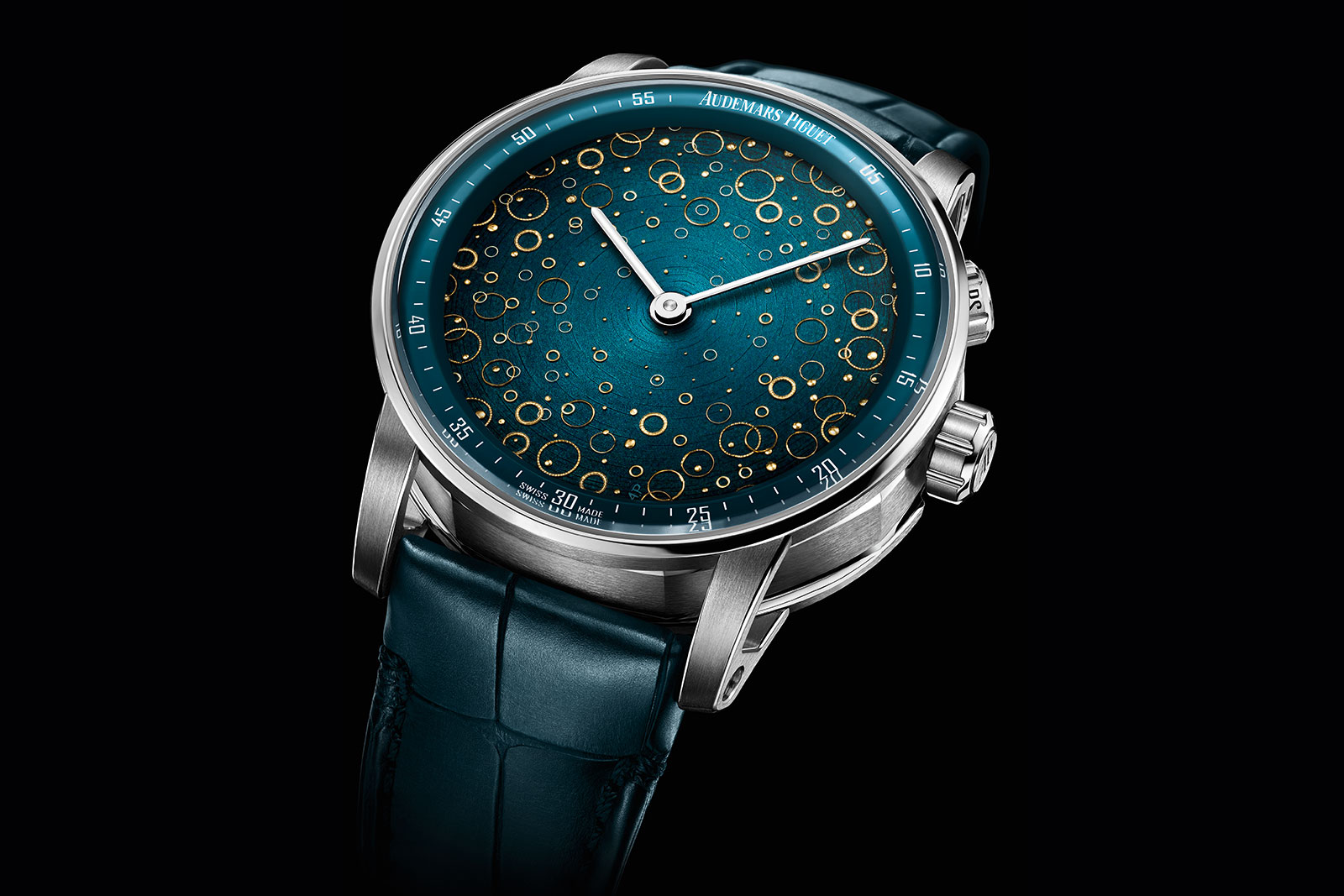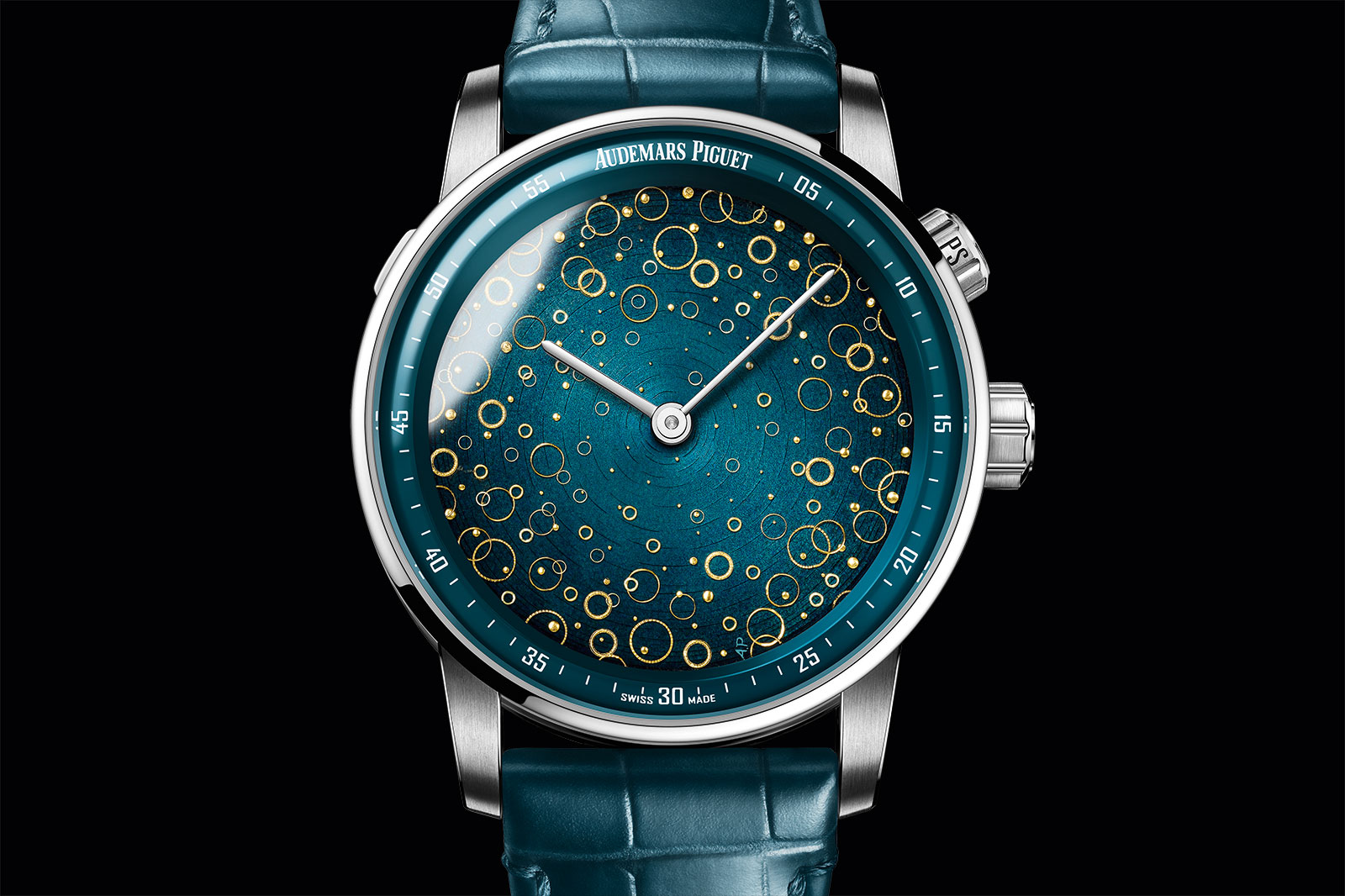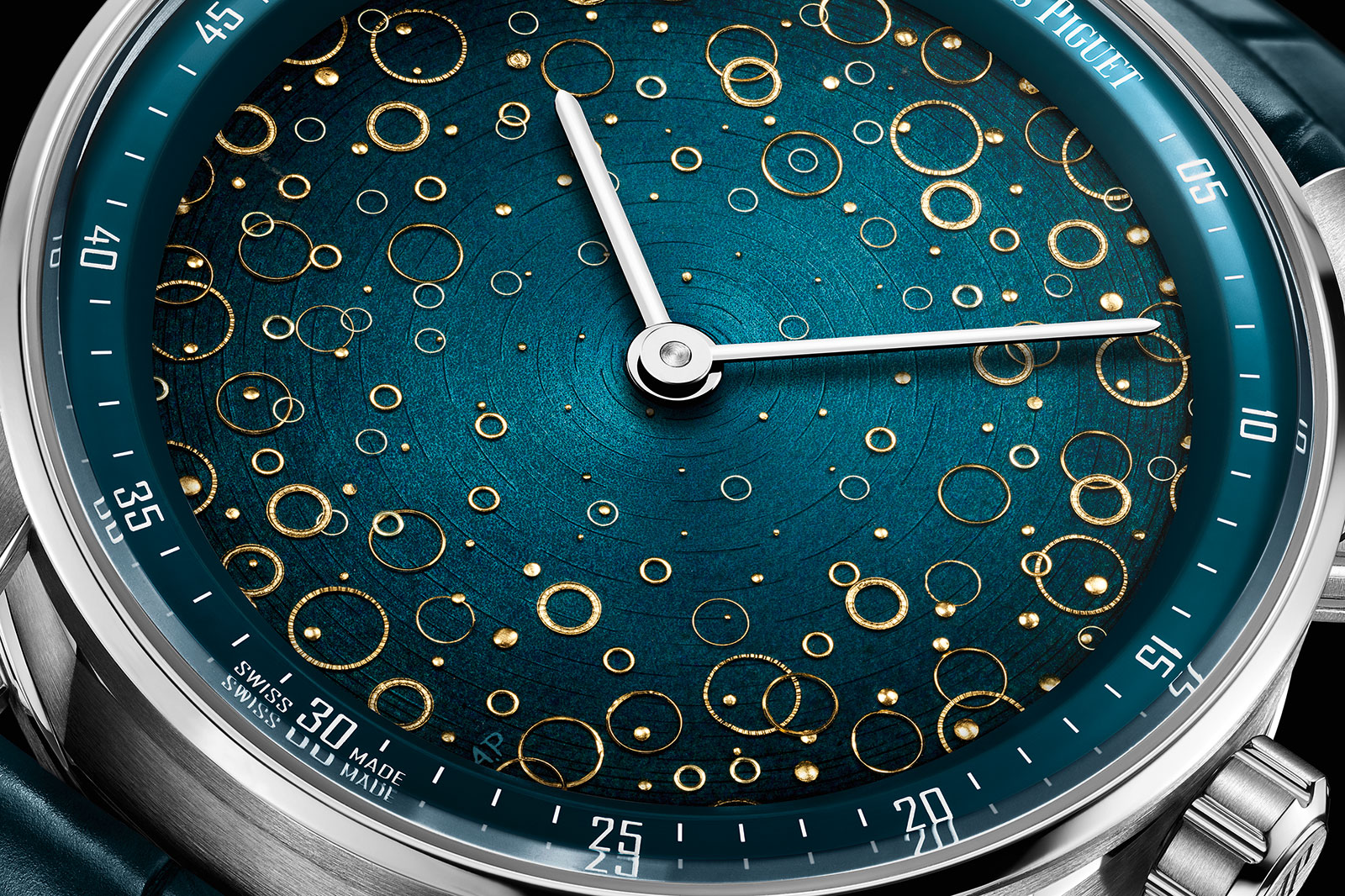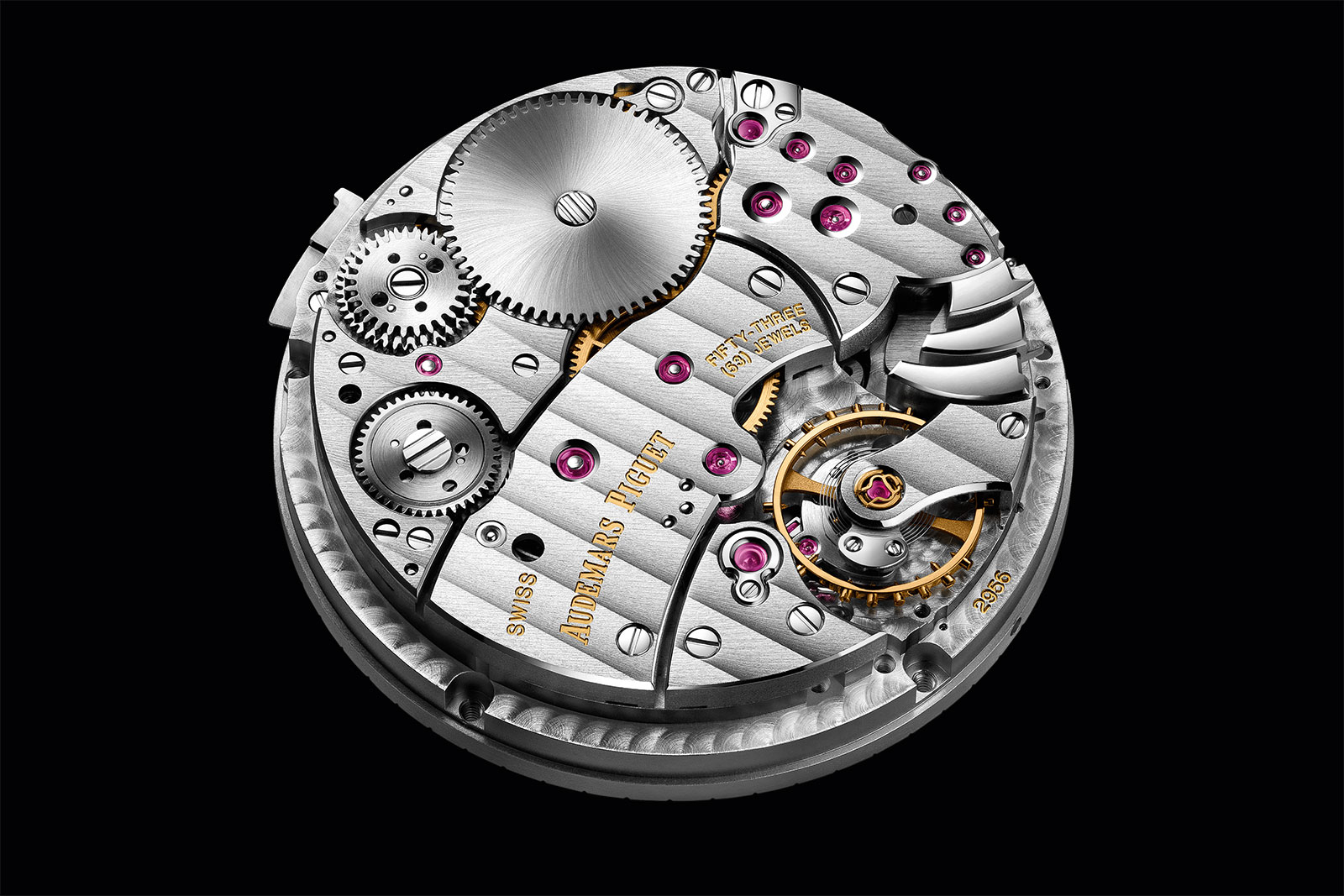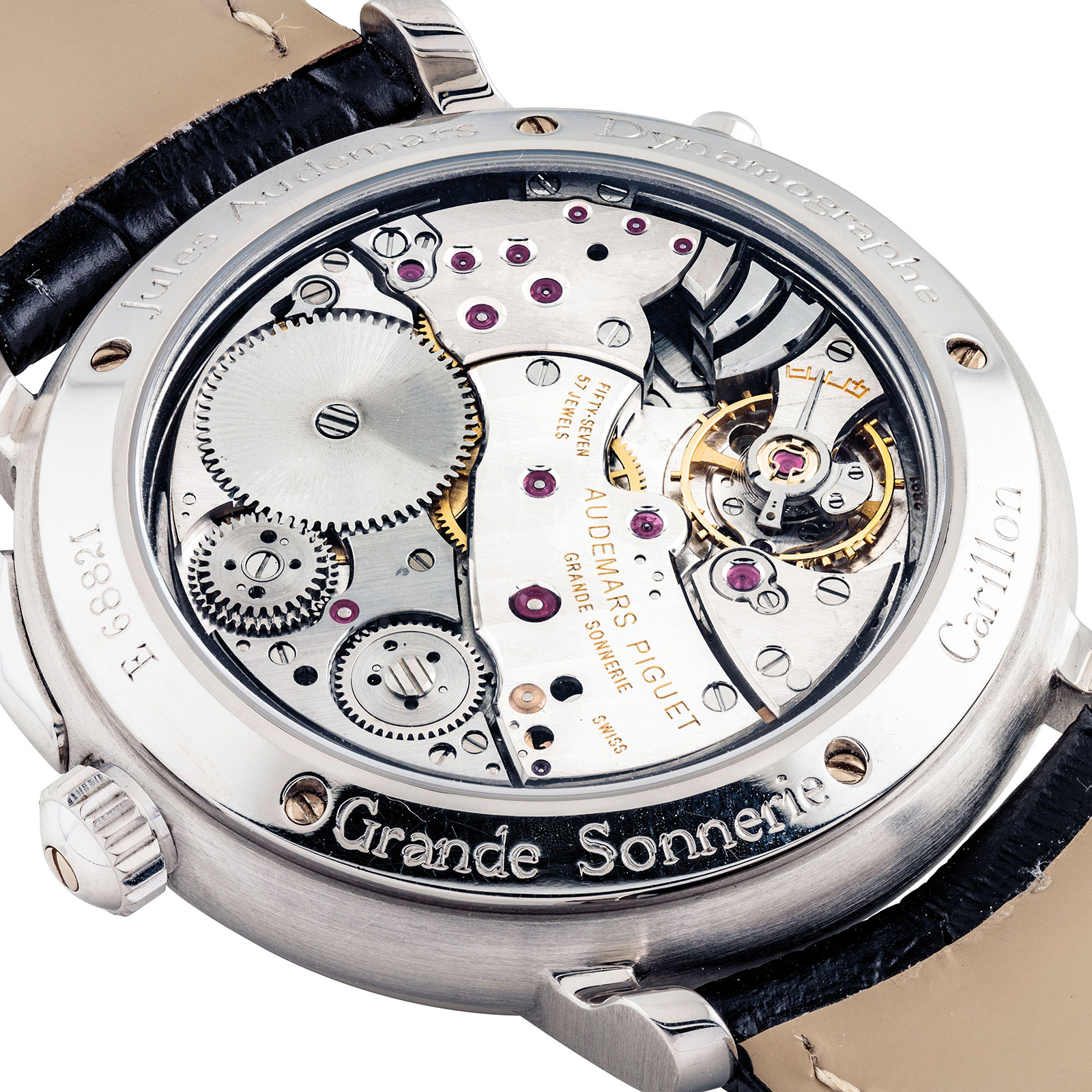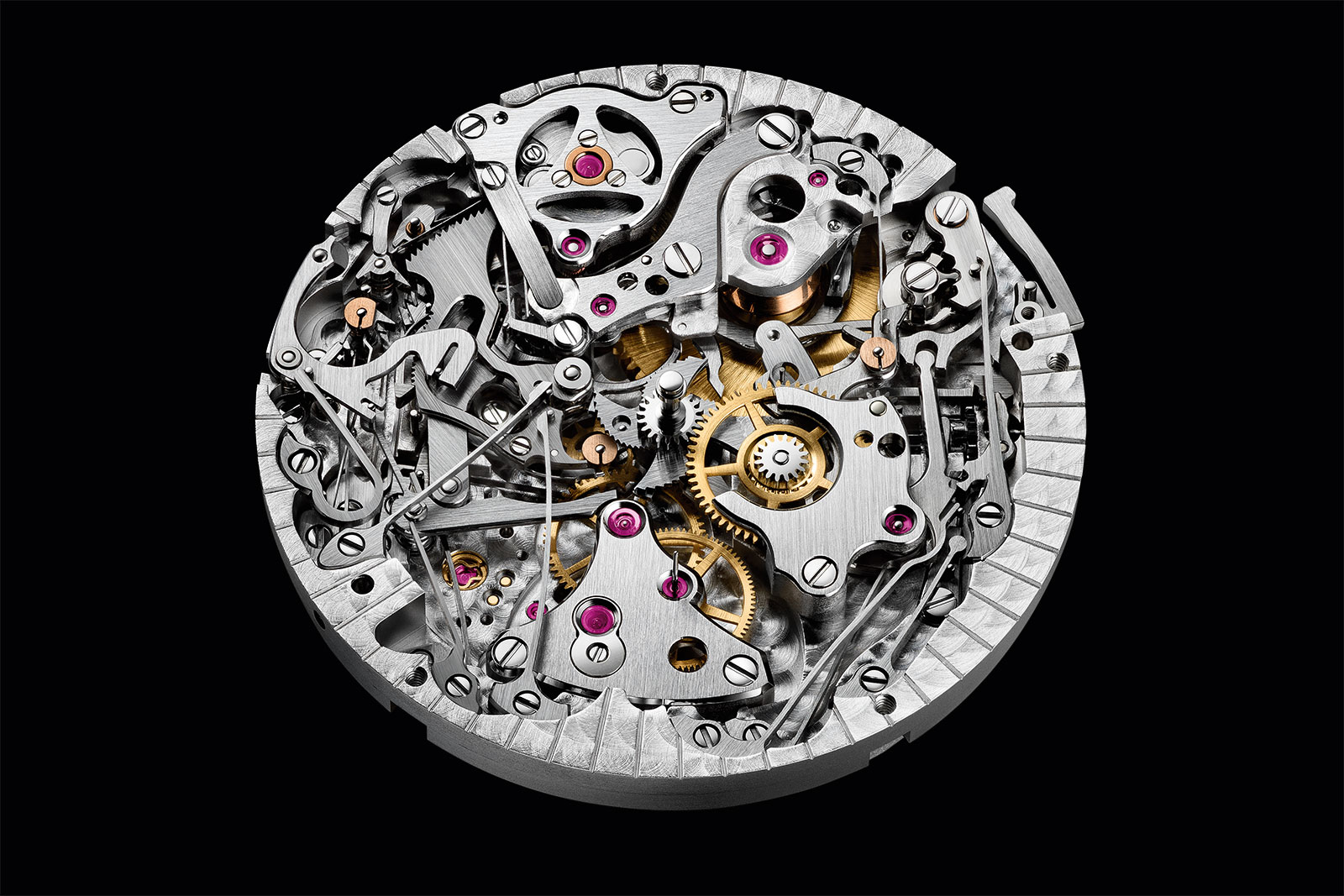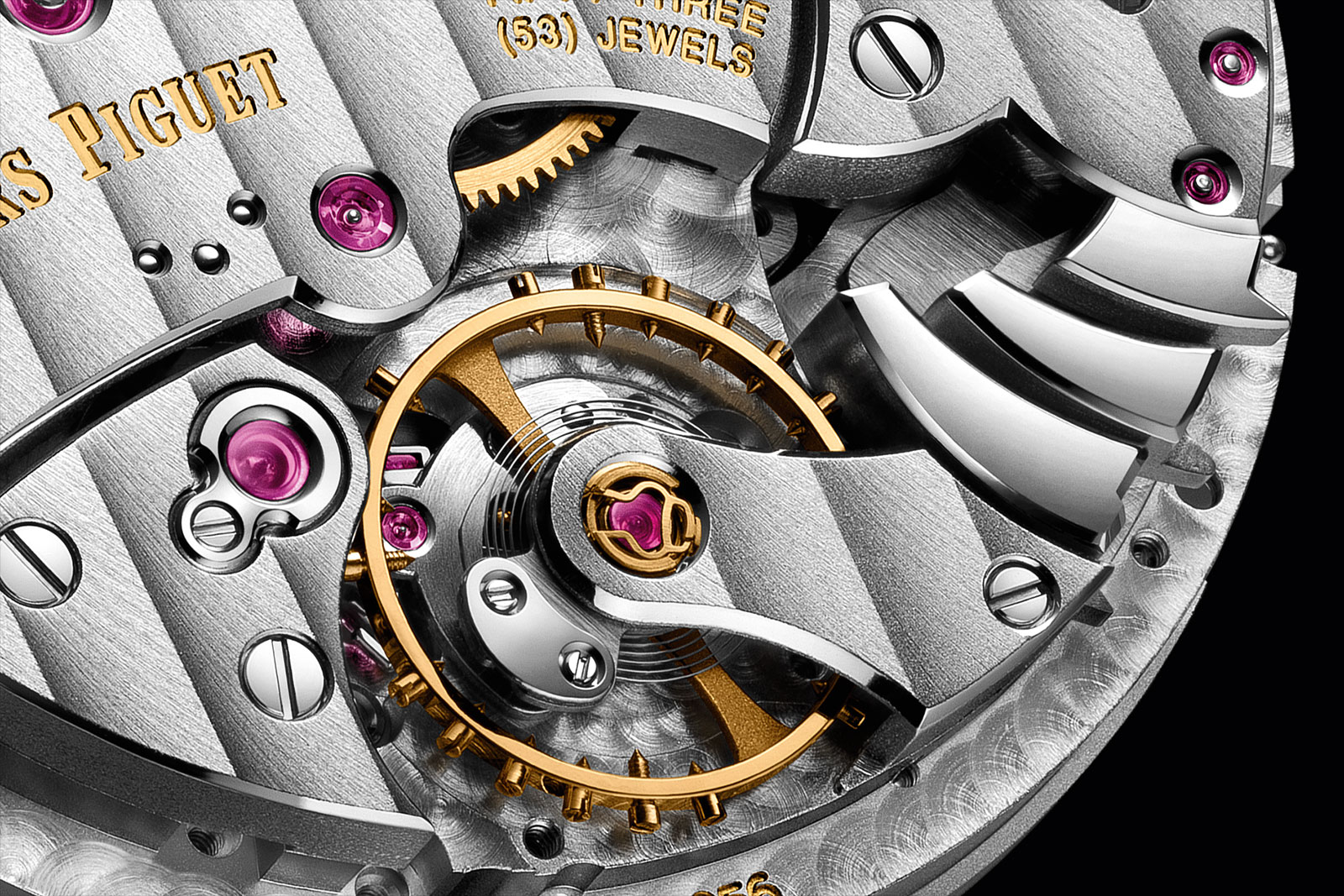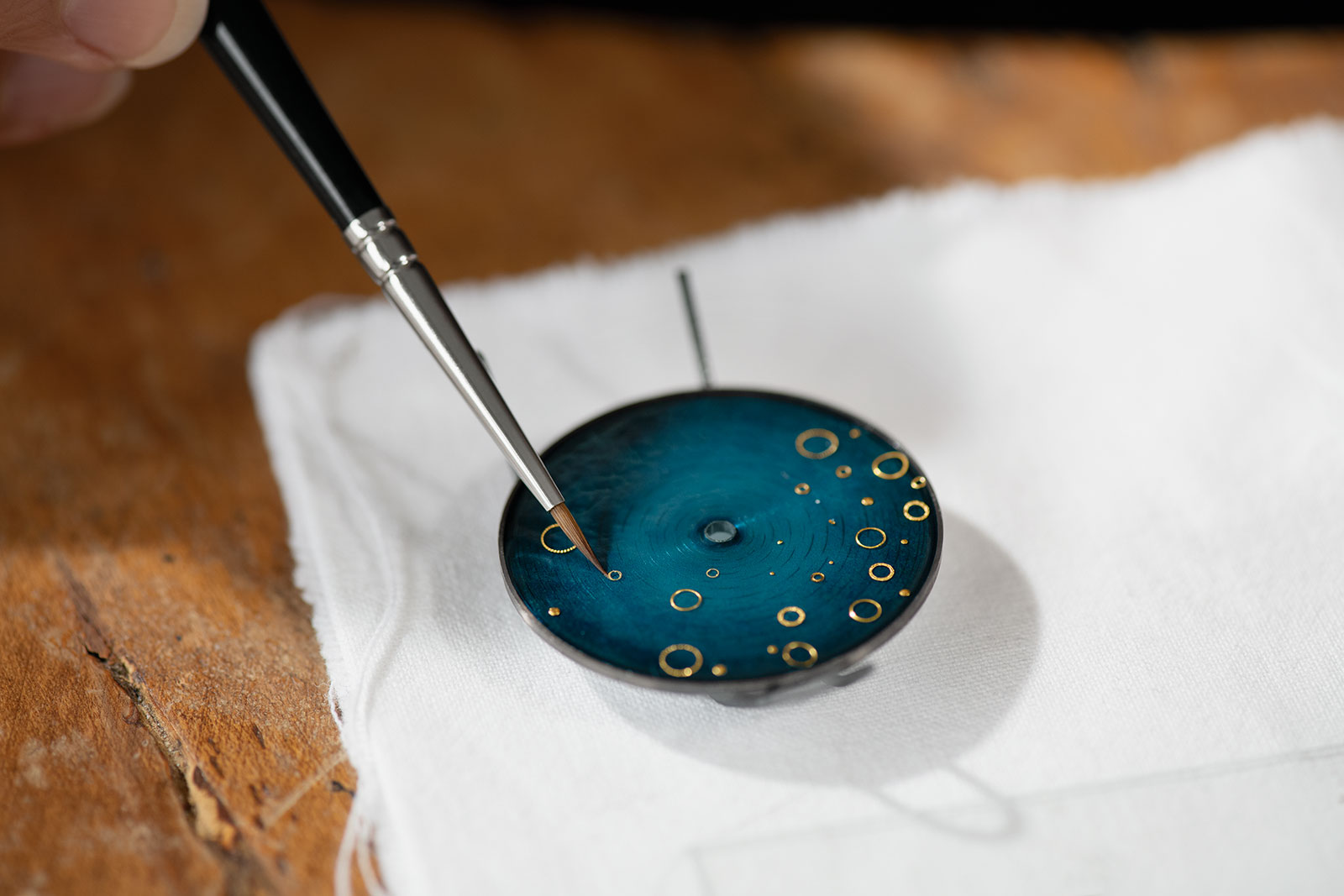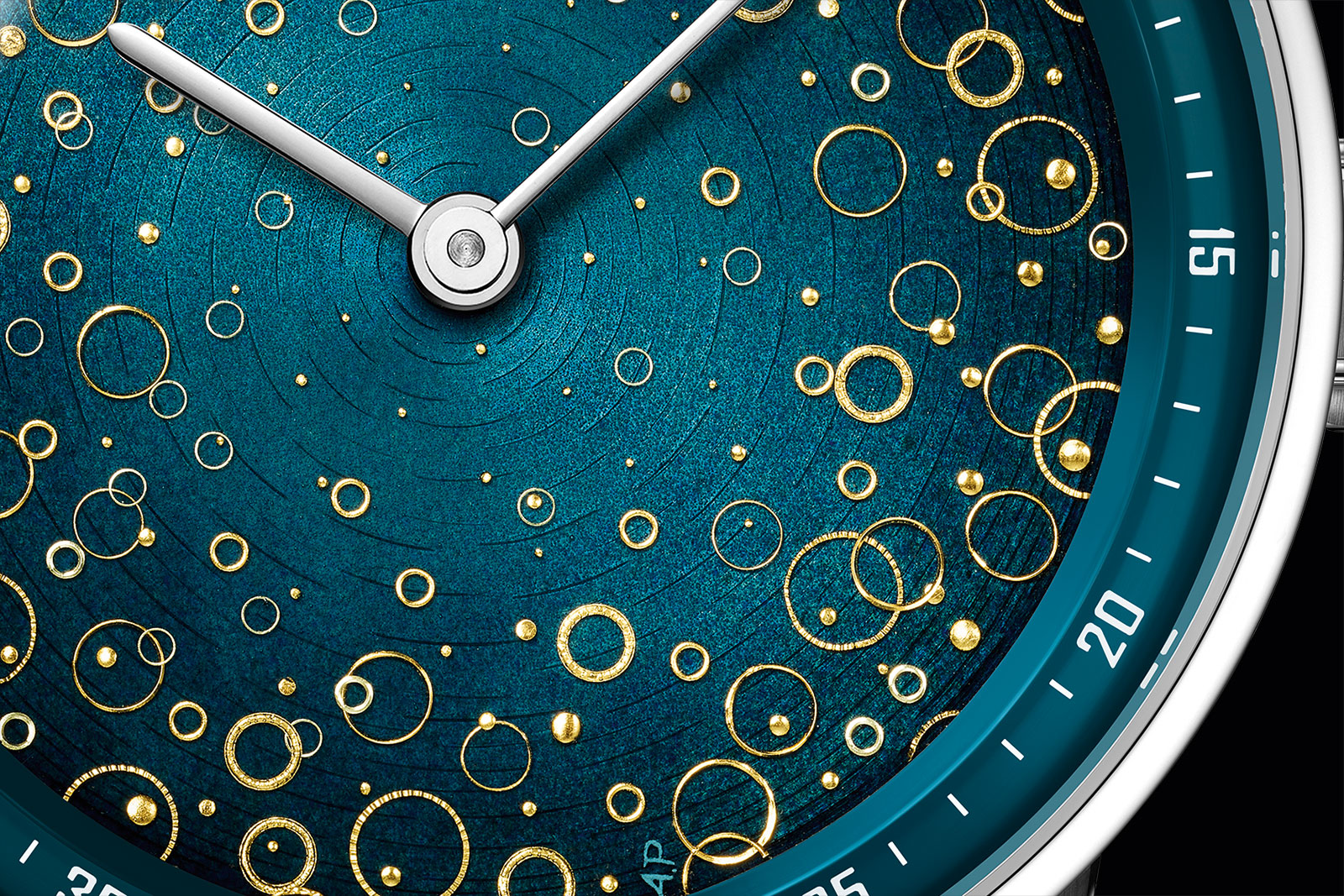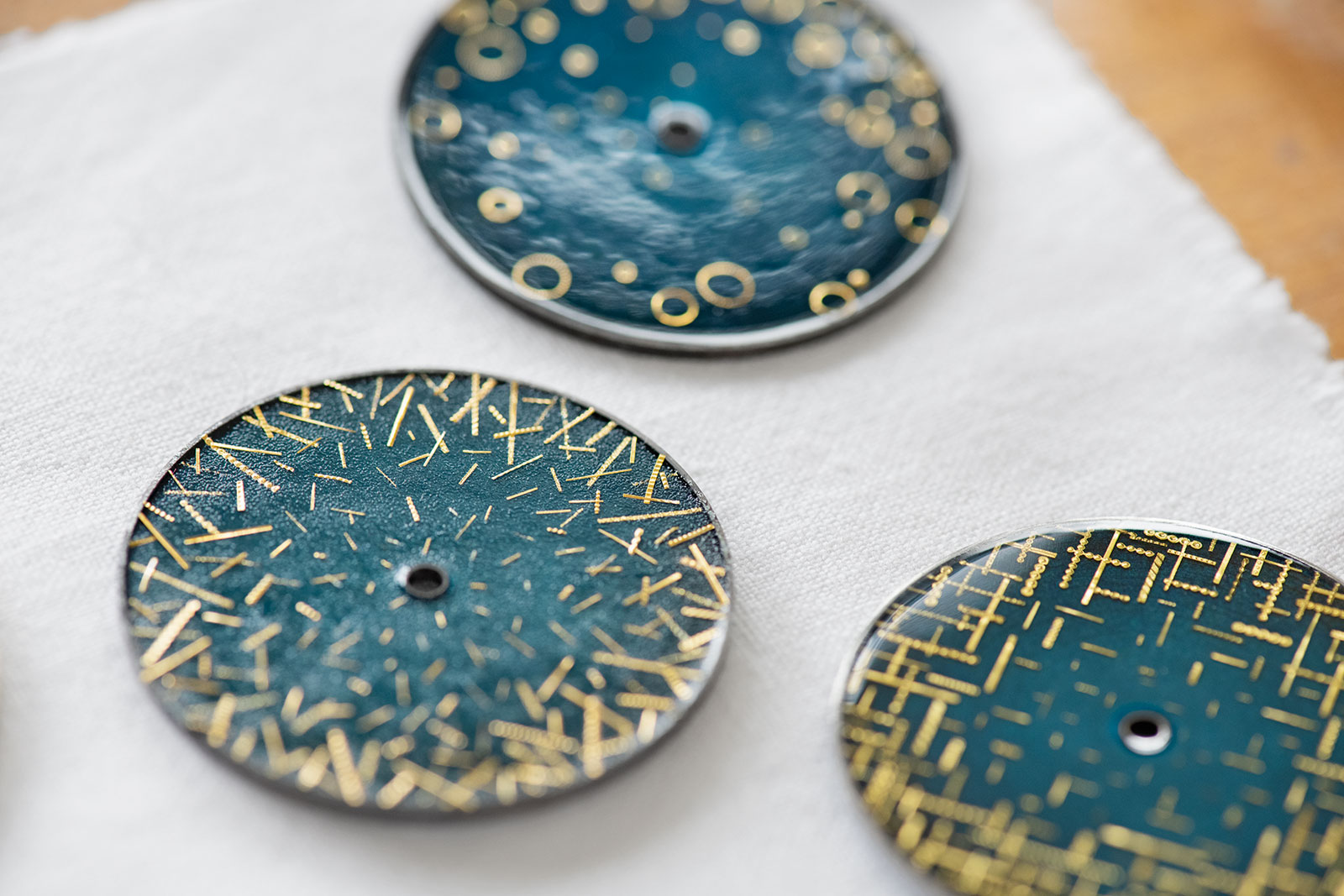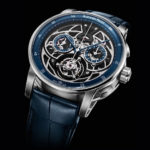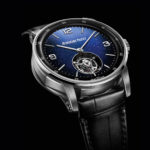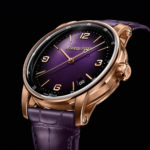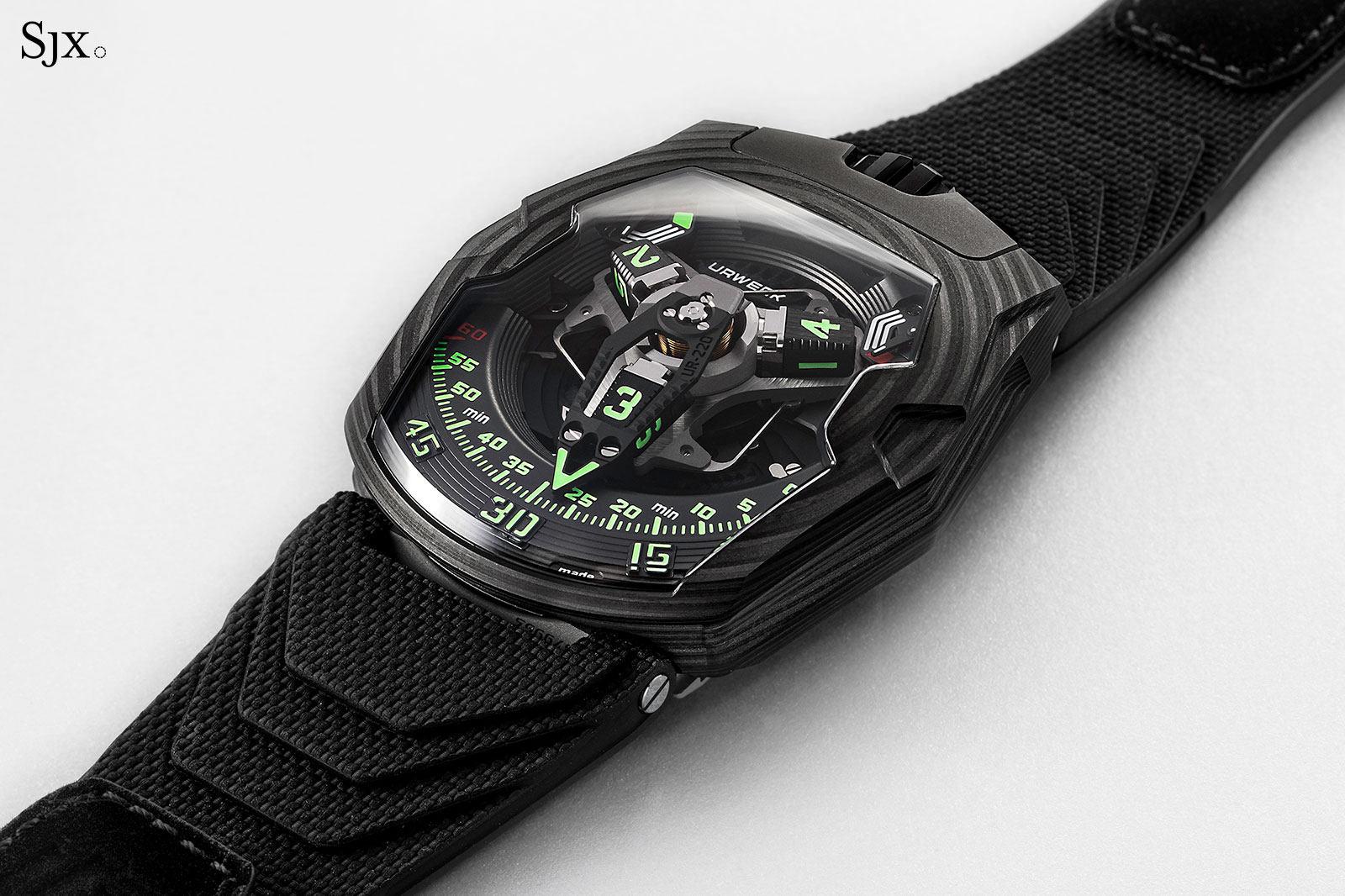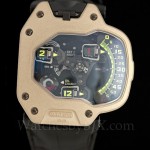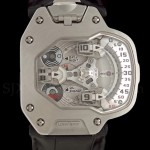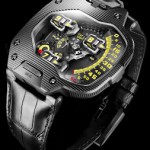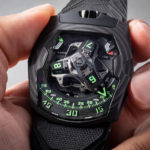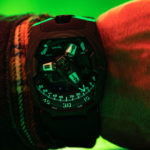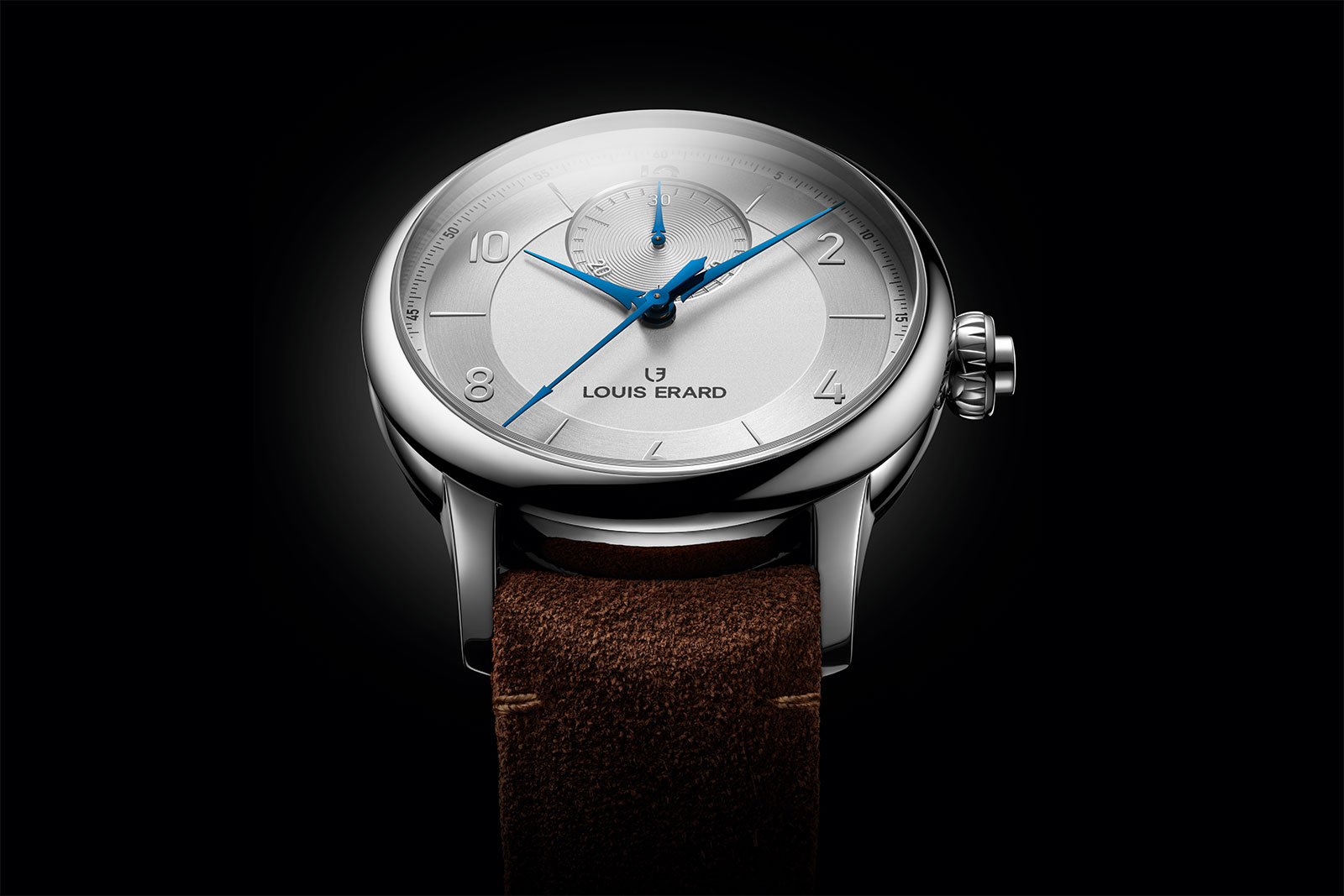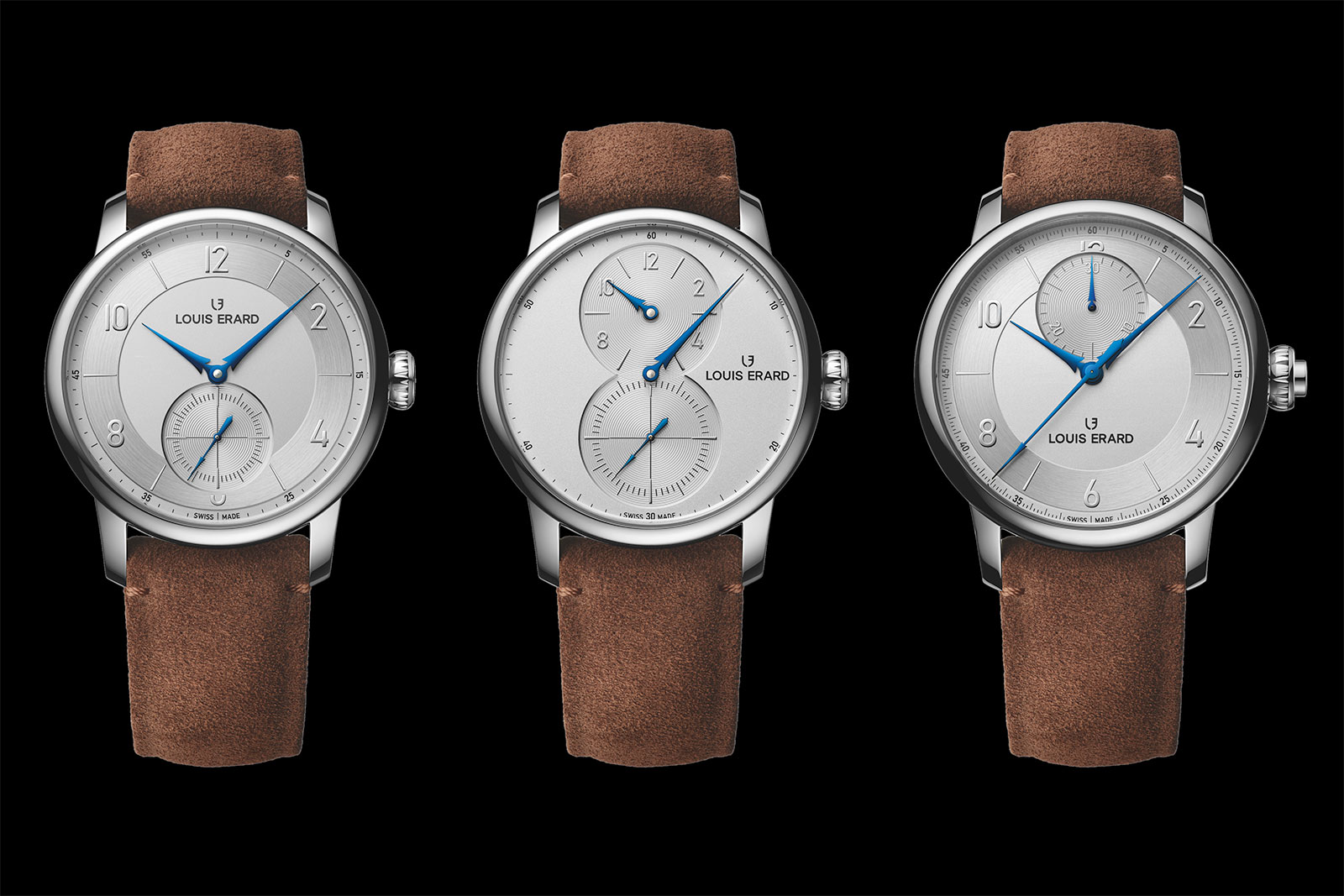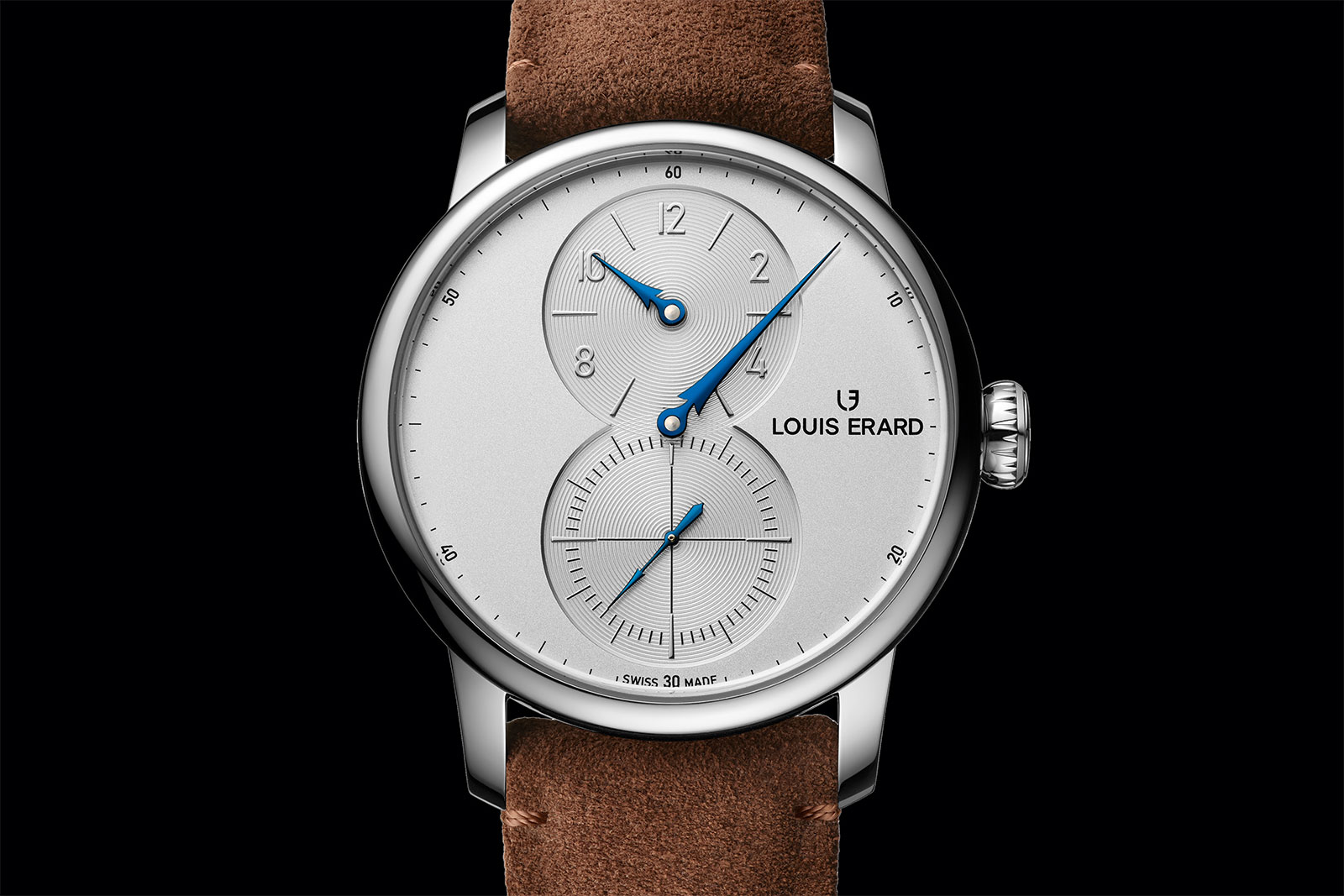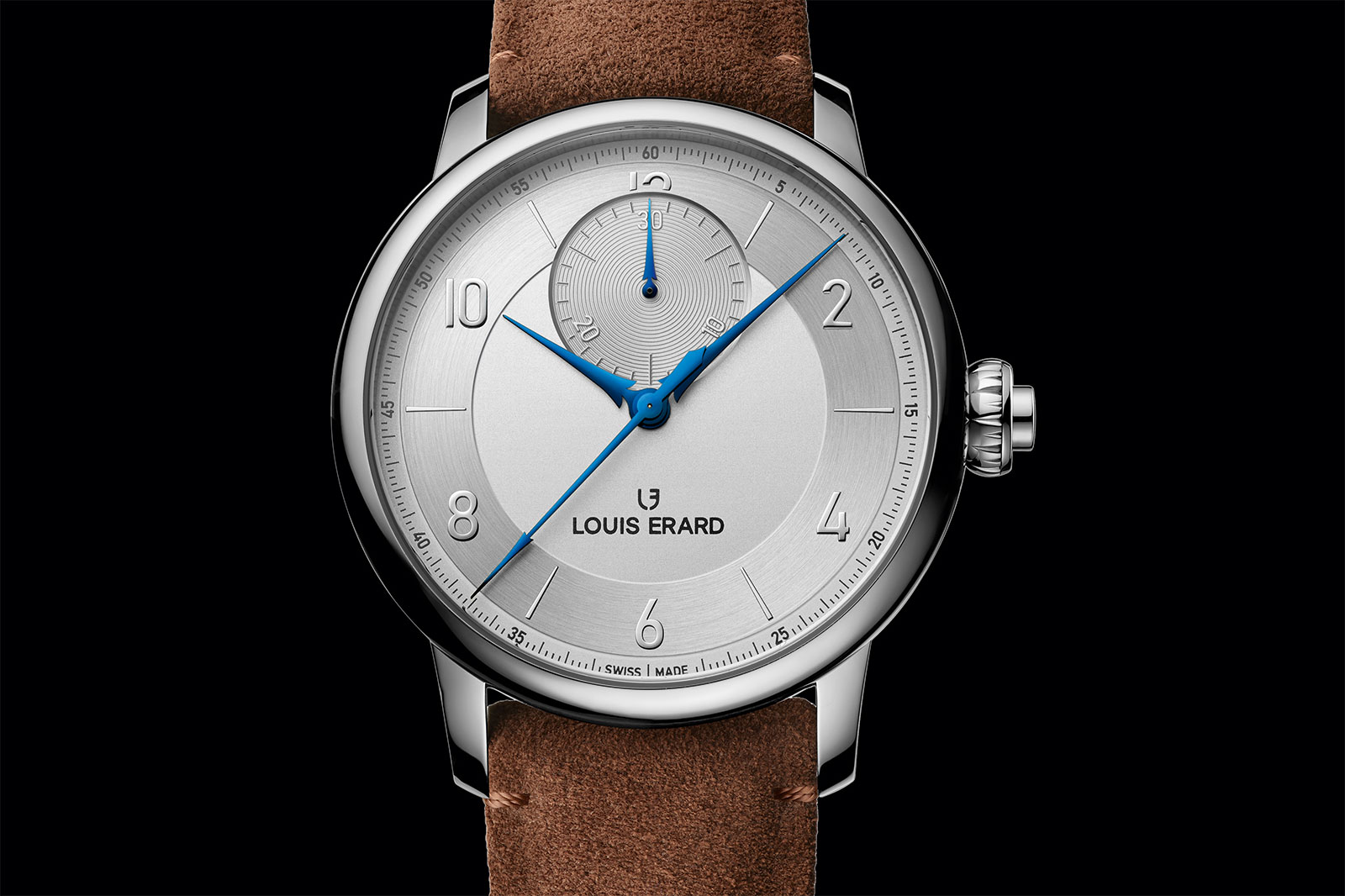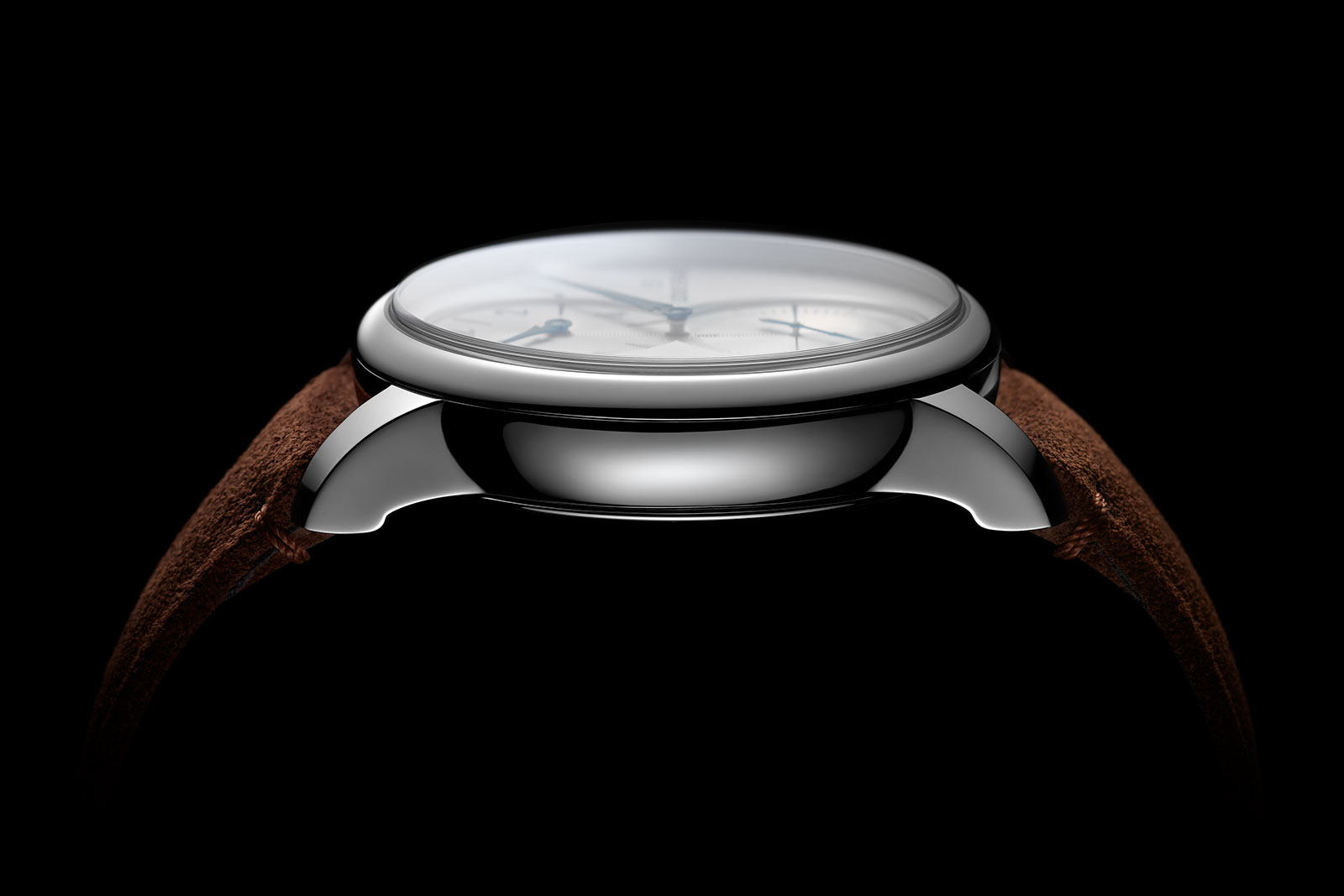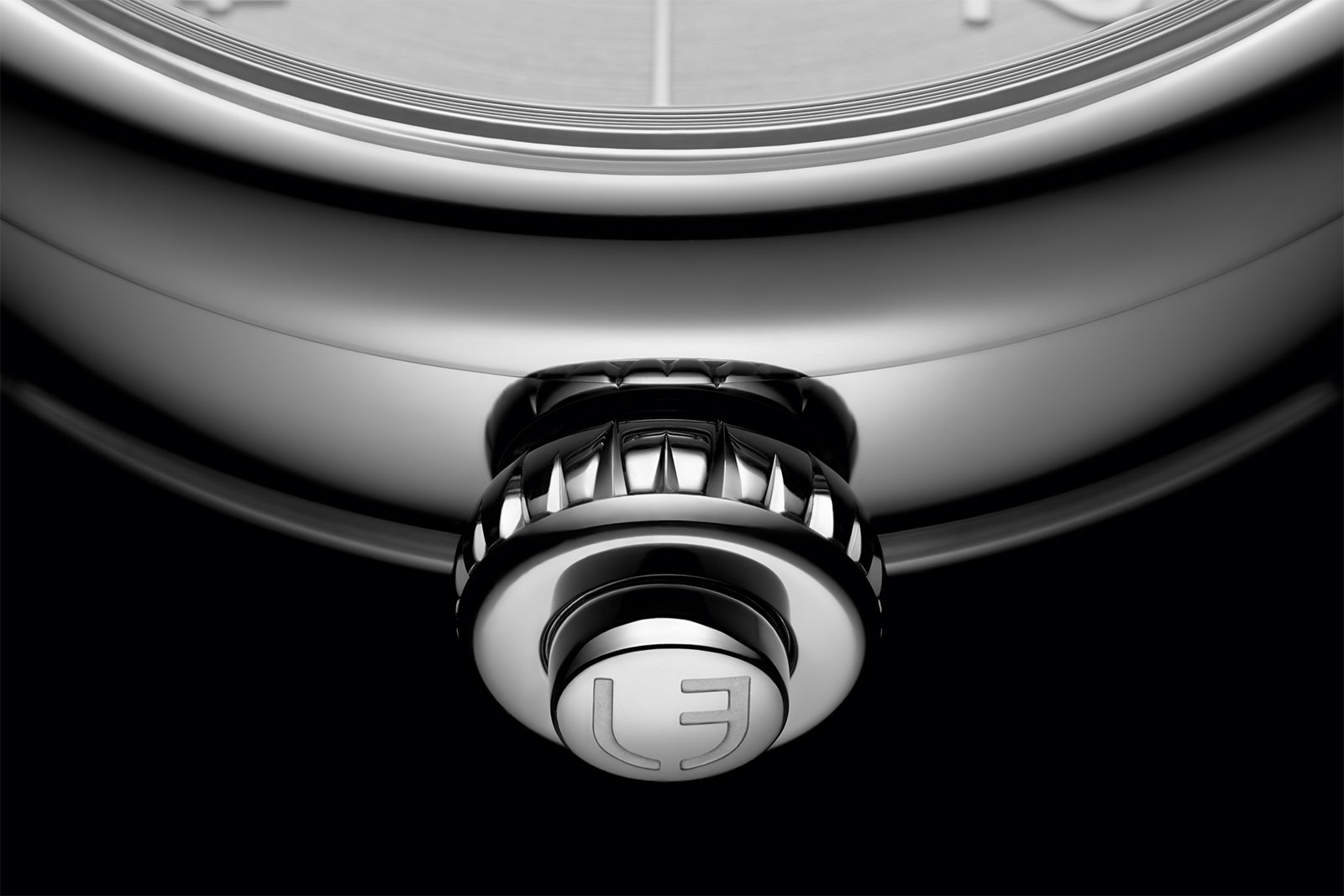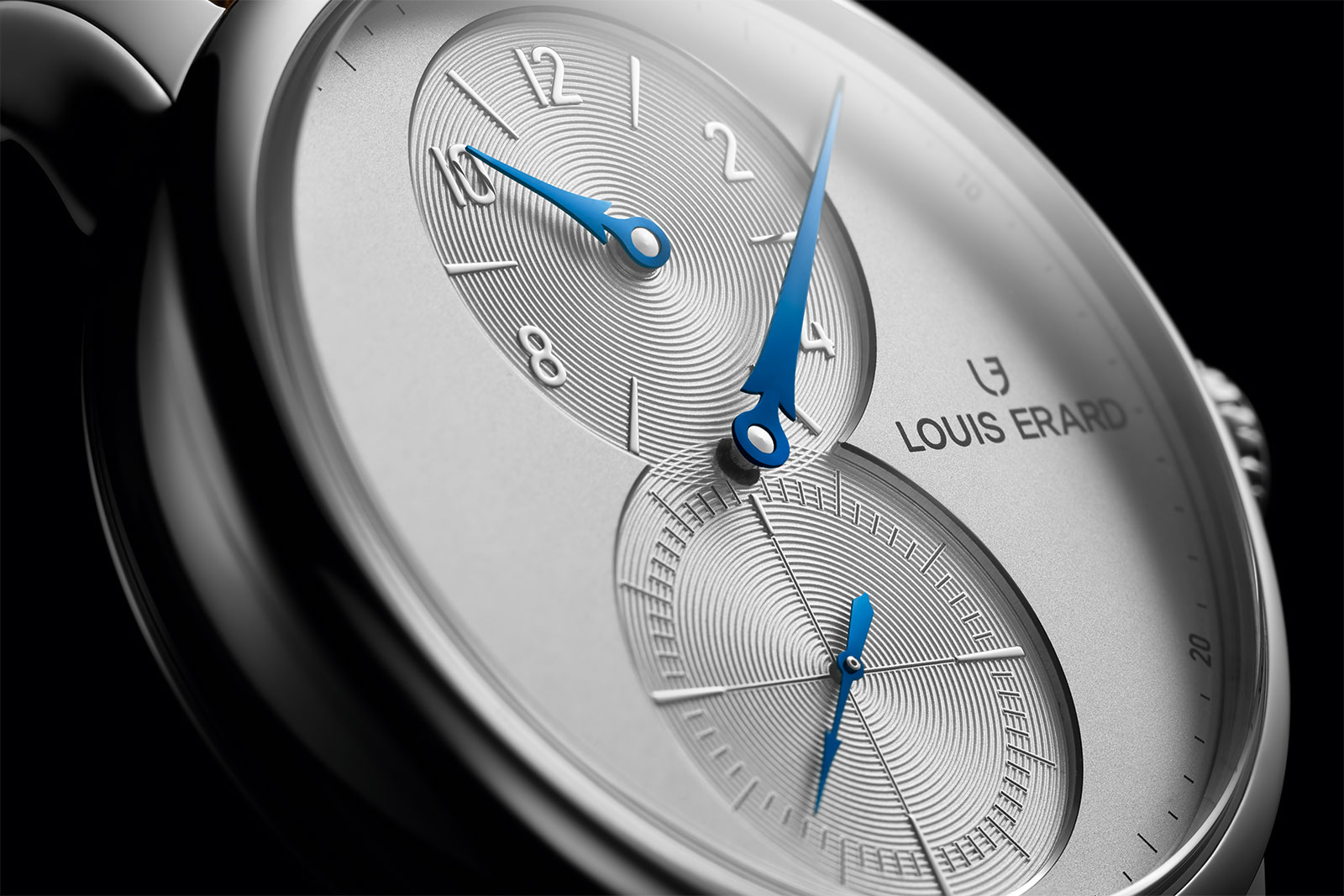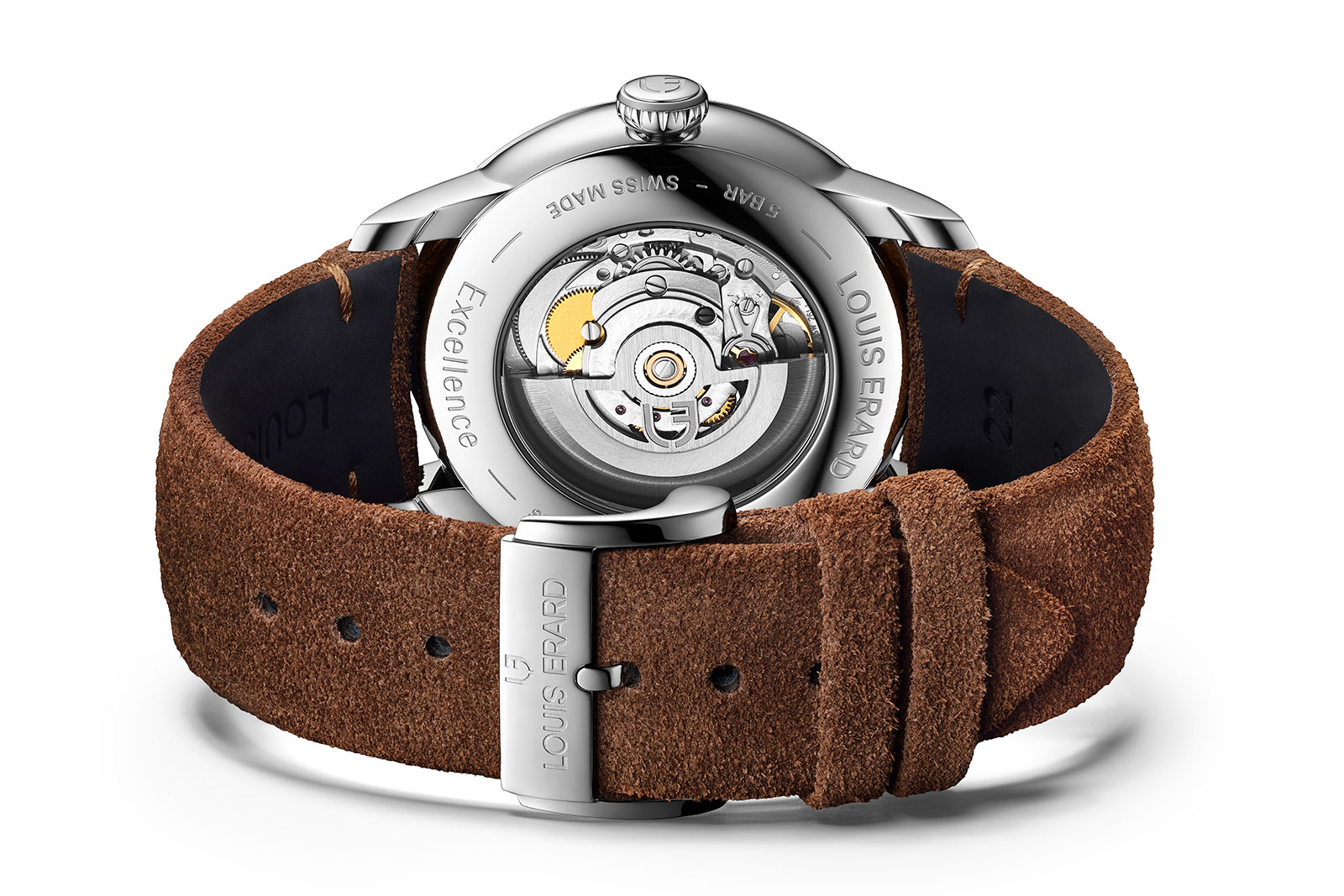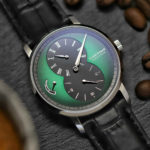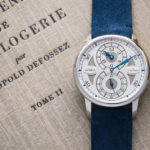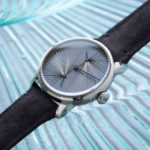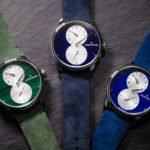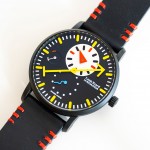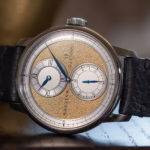Fifteen years after its debut in the Harry Winston Opus V, Urwerk’s ingenious satellite-cube time display is now in its fifth generation with the just-launched UR-220 ‘Falcon Project’. While the UR-220 resembles its predecessor, the UR-210, a great deal, the new watch has been refined in several substantive ways. Most notably, it is powered by a hand-wind movement, something that’s not been used for the satellite-cube display since the UR-201 from 13 years ago.
Initial thoughts
A three-dimensional wandering hours, the satellite-cube hour display is one of the most significant innovations in modern-day independent watchmaking. Hours are indicated on three rotating cubes, while a retrograde hand points to the minutes, travelling in sync with the cube for the current hour. The complication has, however, reached a level of maturity.
Incredible when it was launched in the Opus V in 2005, the satellite-cube display still remains special, though its impact has been moderated by subsequent inventions by other watchmakers, making it seem less avant-garde. So when I first heard Urwerk was soon to unveil the successor to the UR-210, which was introduced in 2012, I was keen to see the evaluation of the complication.
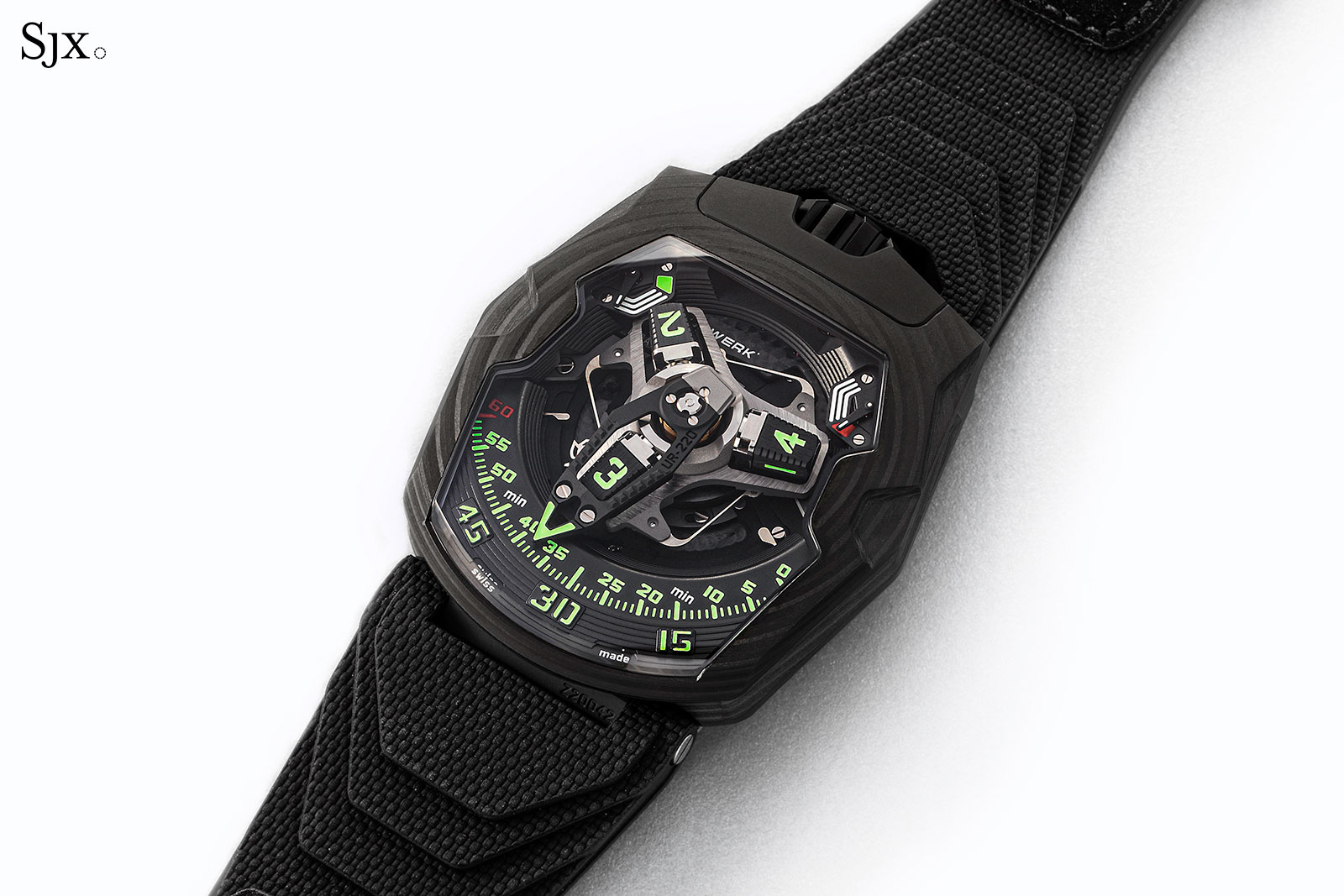
The new UR-220
The UR-220 is unquestionably a better watch – it is slimmer and lighter, as well as face-lifted in terms of design details, and the manual-wind movement is a plus – but it is an incremental evolution over the UR-210, rather than a radical revamp. In fairness, it is difficult to top the satellite-cube display.
As an aside, the fact that the UR-220 is the lightest version of the satellite-cube watch to date might seem incidental, but it is significant. The quintessential version of the first-generation satellite-cube wristwatch, namely the UR-201 and UR-202, was the one in black-coated platinum, which was not very comfortable on the wrist but dense, heavy, and still appealing.
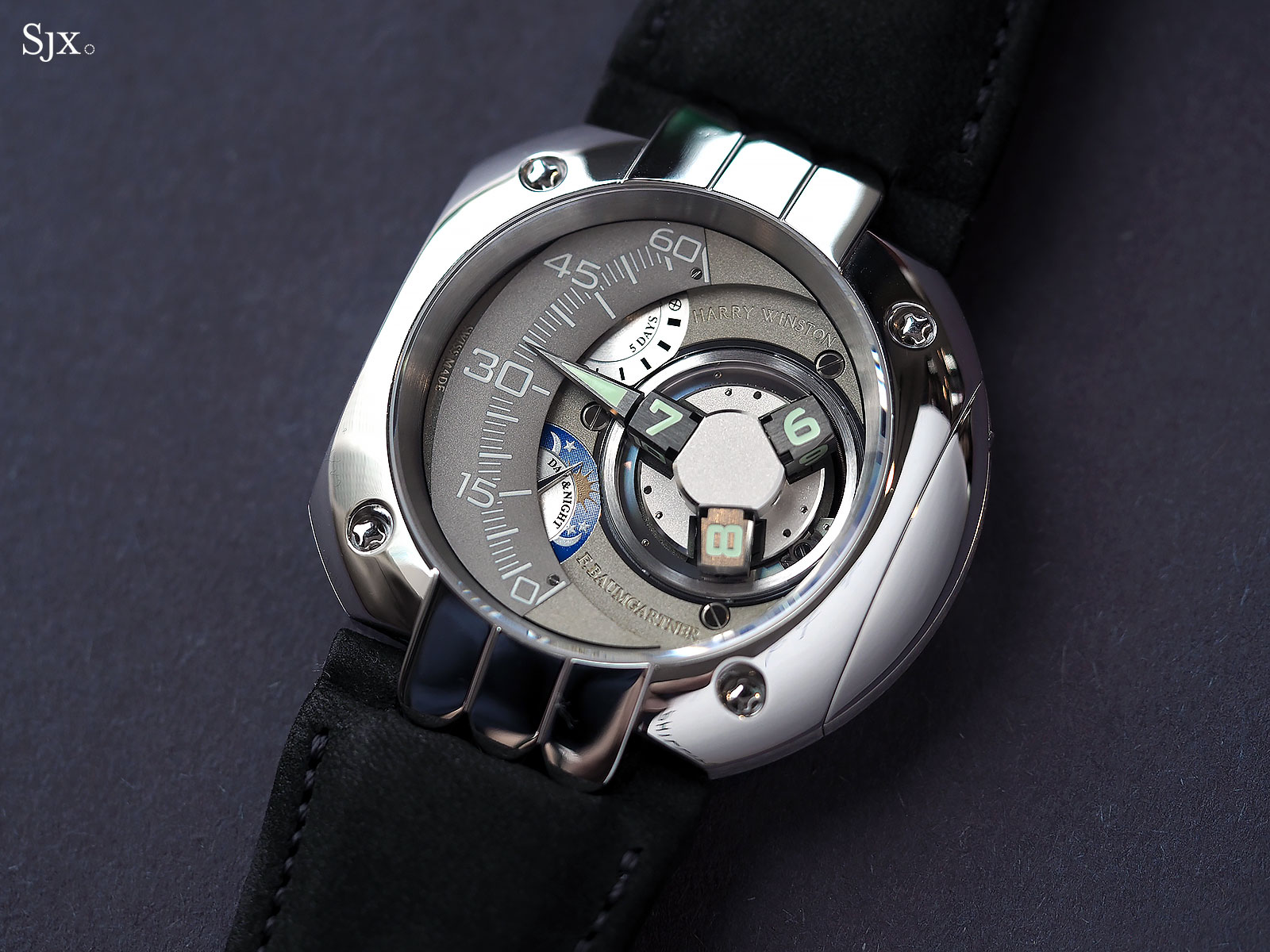
The Harry Winston Opus V in platinum, which was hand wound, like the UR-201; all subsequent models were automatic until the UR-220
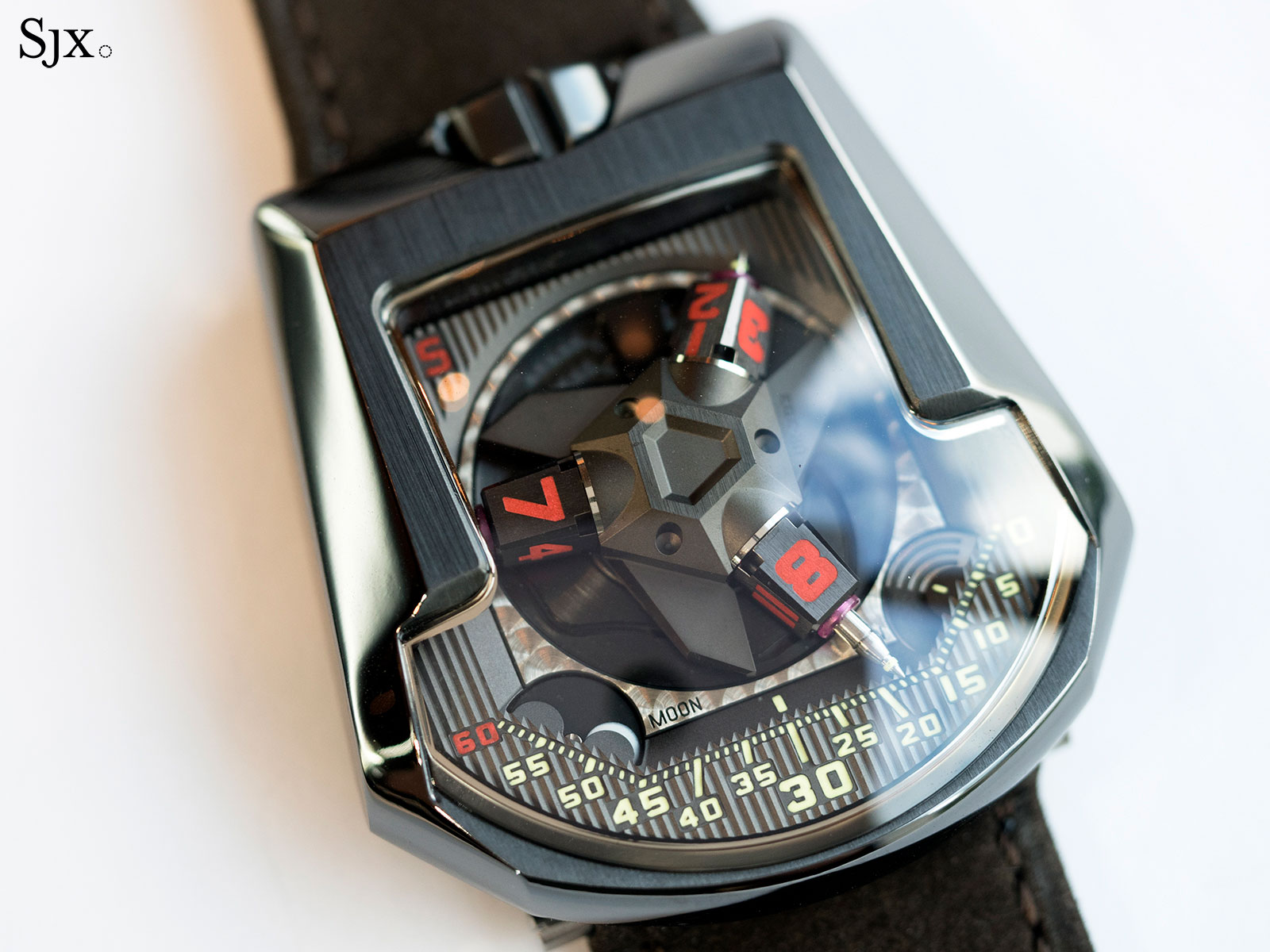
A one-off variant of the UR-202 in black-coated platinum
210 and 220
At a distance, it’s impossible to distinguish the new UR-220 from its predecessor. From the front they are near identical: the UR-220 has a footprint of 43.8 mm by 53.6 mm, exactly the same as the UR-210. But the new model is slimmer at 14.8 mm high, against 17.8 mm. The reduction in height is significant, but even so the UR-220 remains a chunky watch.
Although the case is slimmer, the reduced height is mainly due to the case back, which is now flat instead of slightly domed, made possible by the removal of the automatic winding mechanism. The case middle and profile are essentially identical between the two models. As a result, both look indistinguishable on the wrist, since the domed back on the UR-210 camouflages some of its height.
Up close, it is clear many of the details have been refined, but the changes are only obvious when compared side by side. The UR-220 has finer fluting on its crown, while the linear recesses on its sides are more angular.
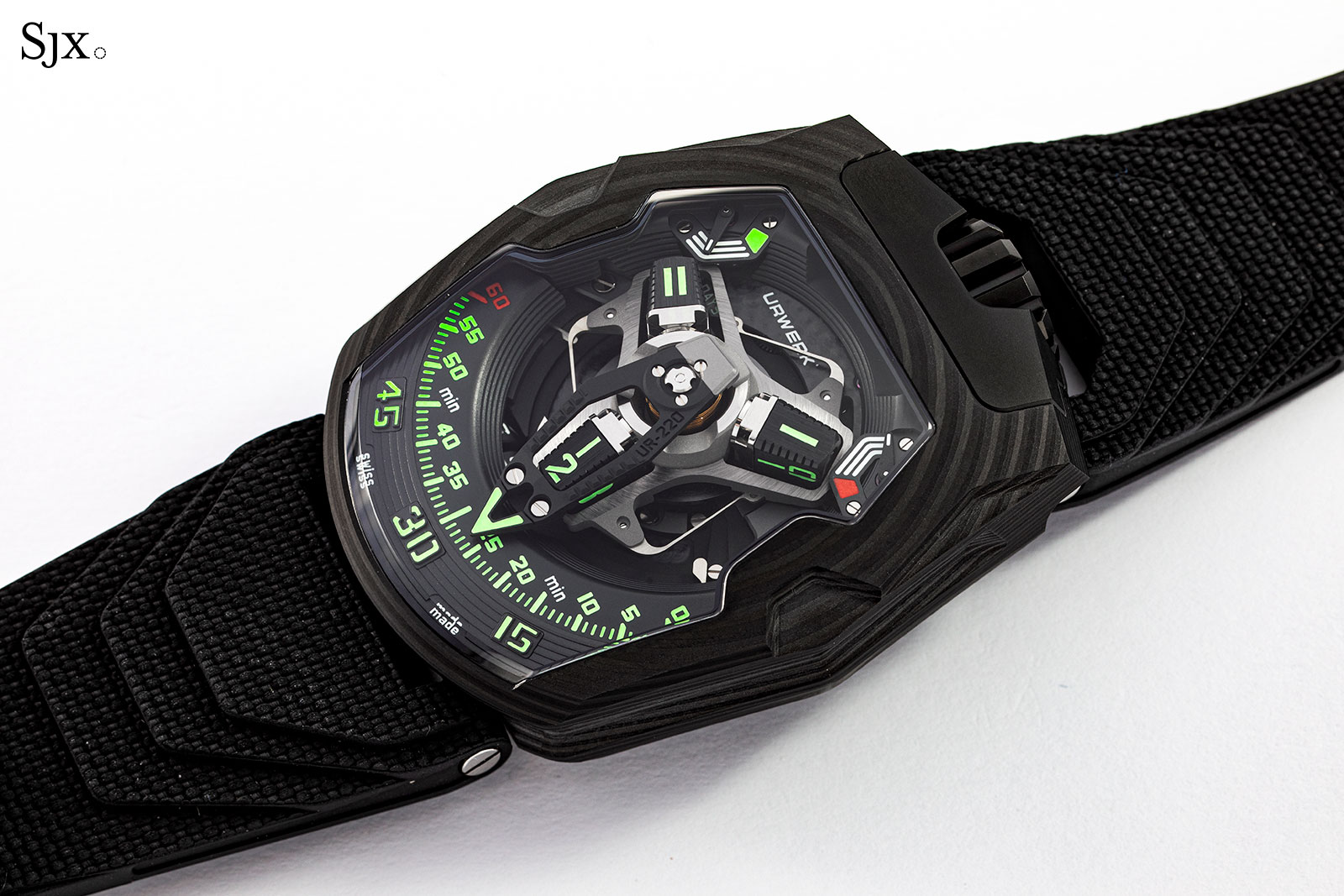
The new UR-220
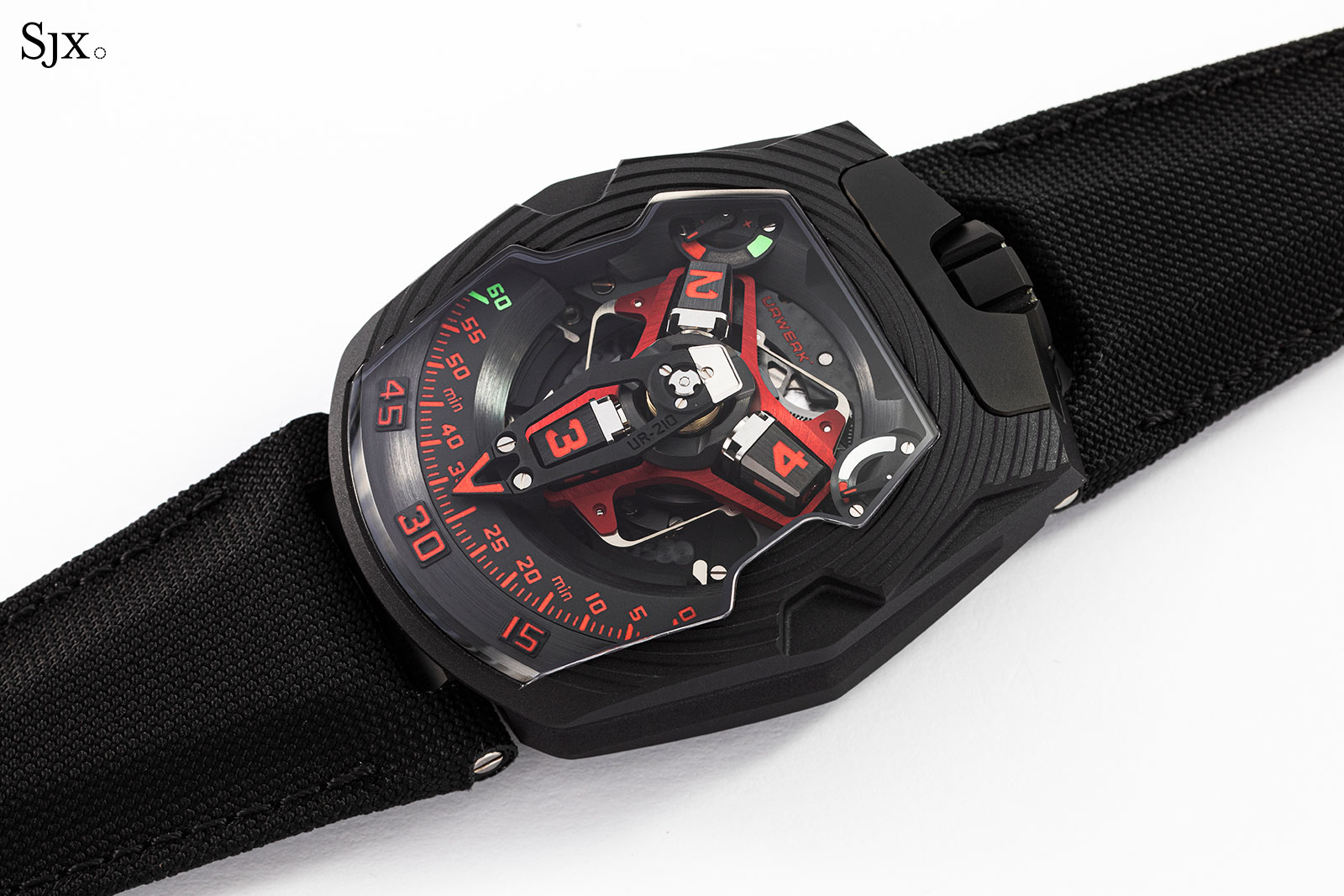
And the UR-210
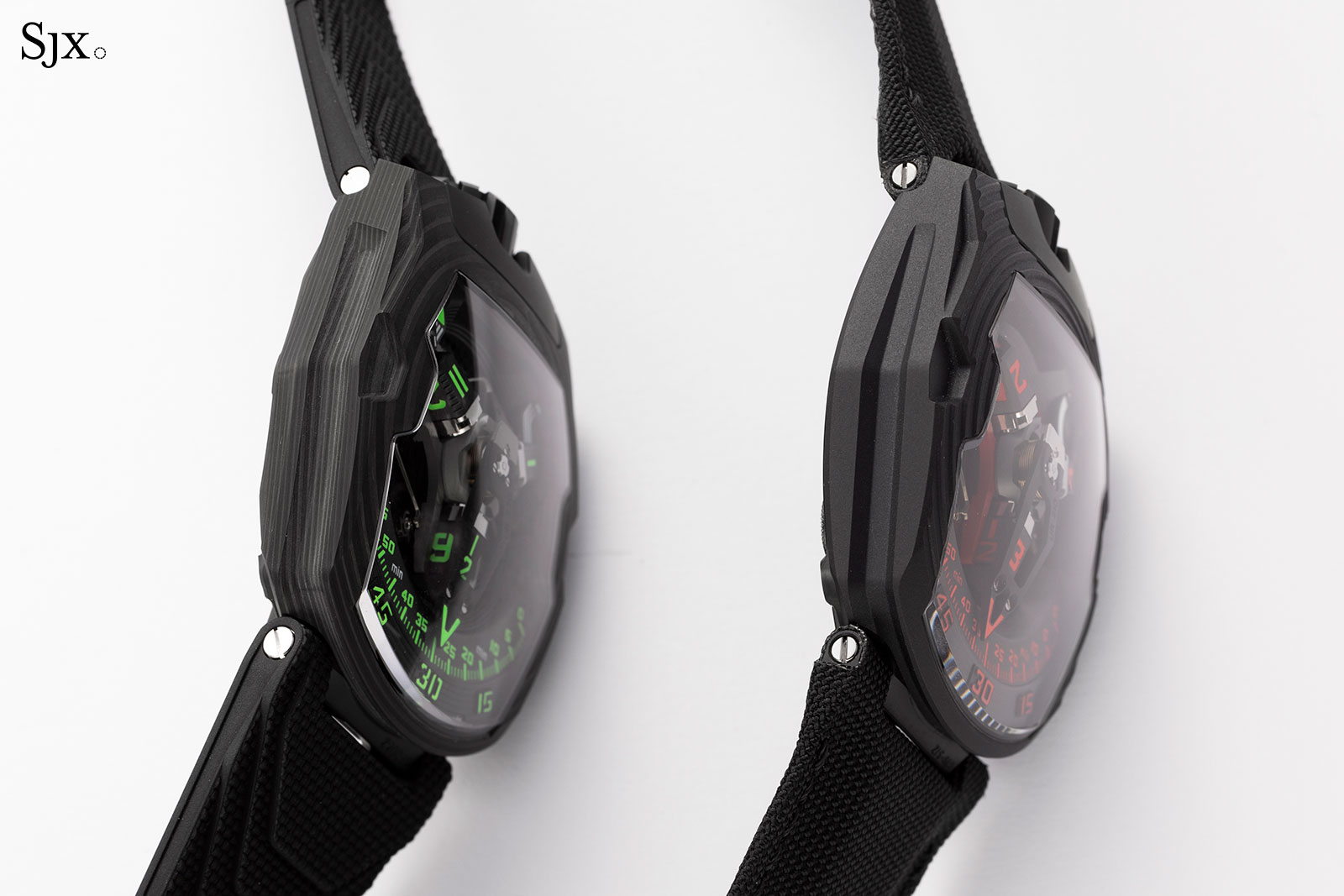
The near-identical case profile
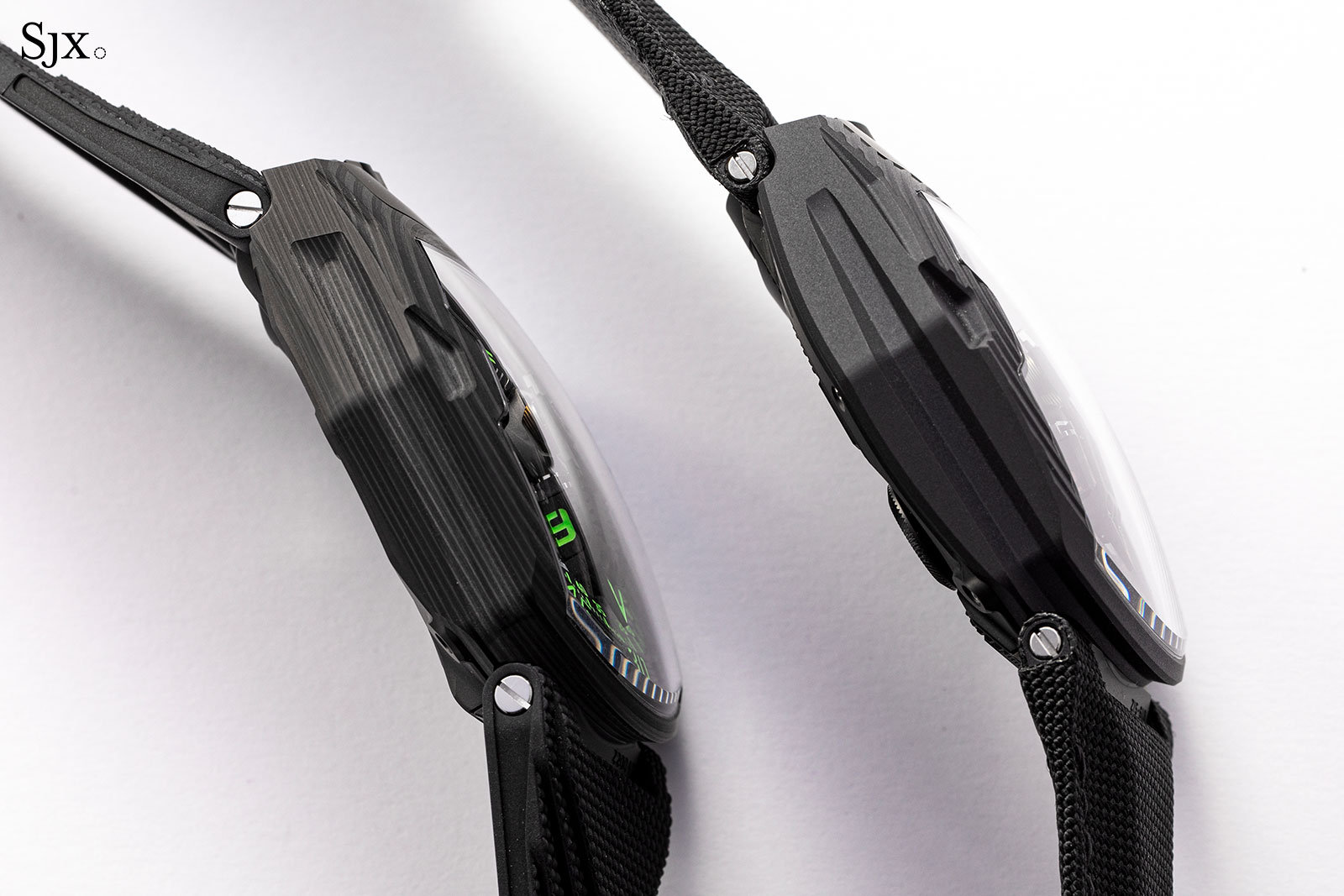
The difference in the case back thickness is discernible
In the hand, the UR-220 is lighter than the UR-210 by a noticeable but insubstantial margin; light but not featherweight like a Richard Mille for instance. Admittedly the comparison between the two generations isn’t fair, since the UR-220 has a carbon composite case while the UR-210 was all metal, but the difference is smaller than expected, perhaps because of the hefty, black-coated titanium case back.

The flat back of the UR-220 (left), and the UR-210 with its winding efficiency selector

The flatness of the back is not obvious because of the lack of contrast, but it is tactile in the metal
The new strap – rubber topped with a woven-carbon fabric – also helps the watch sit better. Because it is large and light, and the strap can be worn snugly, the watch sits better on the wrist than the UR-210.
That said, the end of the strap lacks a stopper – it’s essentially an open-ended loop – meaning it can slip out of the metal ring, which makes putting it on a bit of a challenge initially.
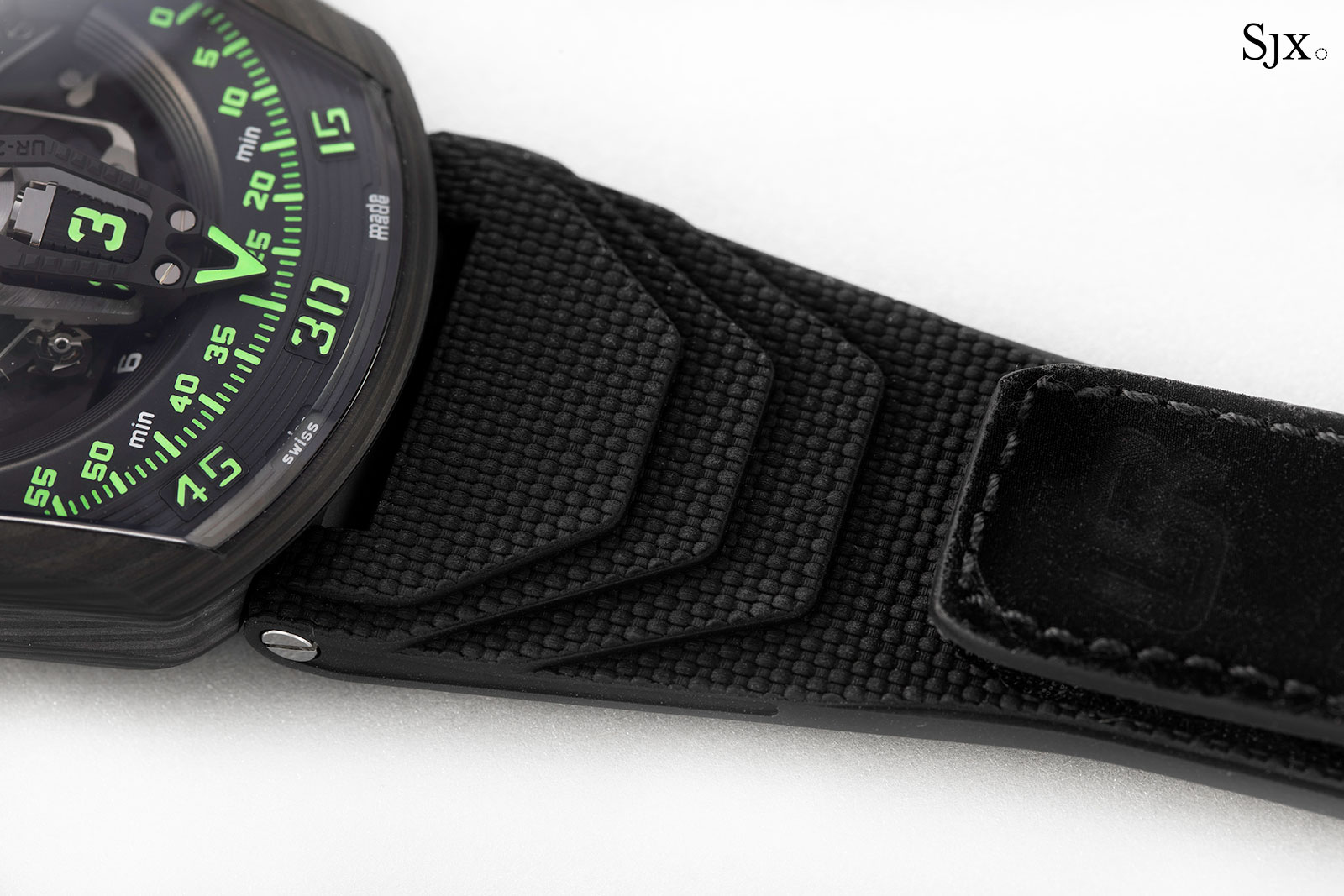
Mechanical differences
Although the UR-220 is hand-wind – making it the first manual-wind satellite-cube display watch since 2007 – it shares the same movement as its automatic predecessor. Both are powered by the Zenith Elite, an automatic in its original form and the base calibre for majority of Urwerk’s current movements.
In the UR-220 the Elite has been modified to remove the automatic-winding mechanism, turning it into a slimmer, hand-wound movement. On the other hand, the UR-210 and earlier models elaborated upon the automatic mechanism to give it “turbine” winding with adjustable winding speed.
While the Elite is clearly reliable and robust, it is an older movement, having been launched at Baselworld 1994. It has a 55-hour power reserve in its basic form, and 48 hours in the UR-220, which is relatively short by current standards where three days is almost the norm.

The UR-220 (left) and UR-210
Key features
Urwerk’s trademark satellite-cube display for the hours is an ultra-elaborate take on the traditional wandering hours complication. Even though it is exceptionally complicated mechanically – the display travels on both the horizontal and vertical planes – it is easy to read, which is the genius of it.
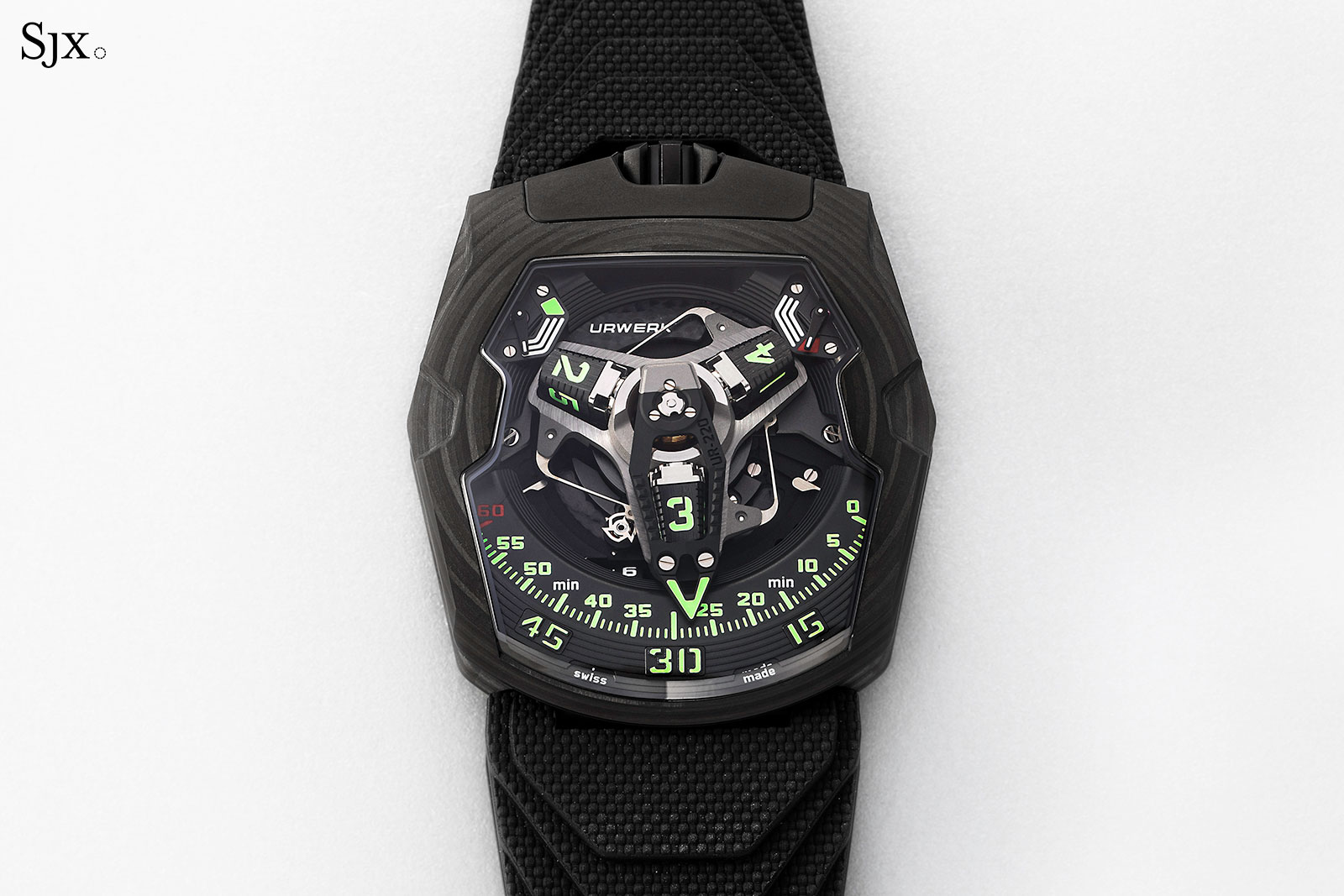
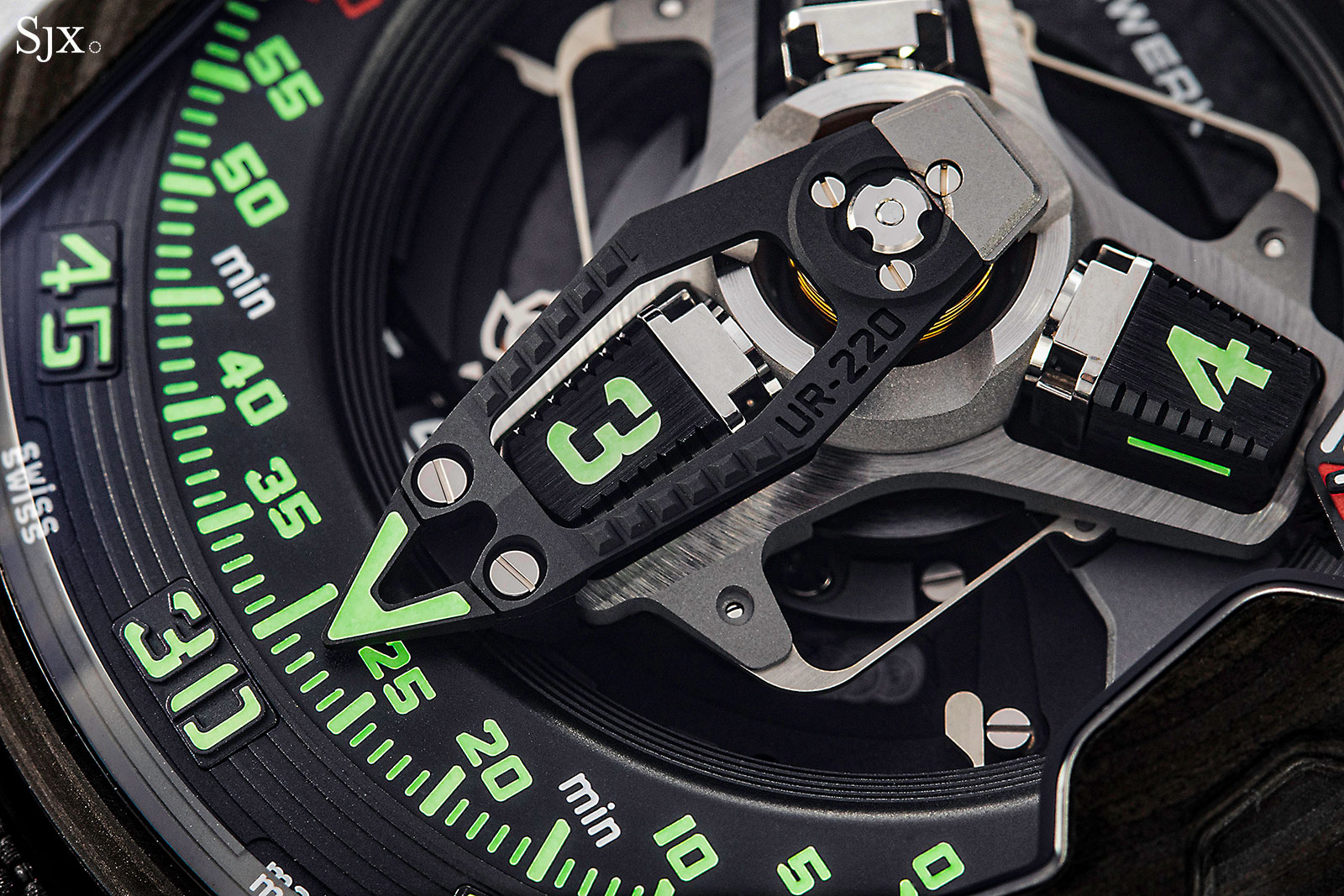
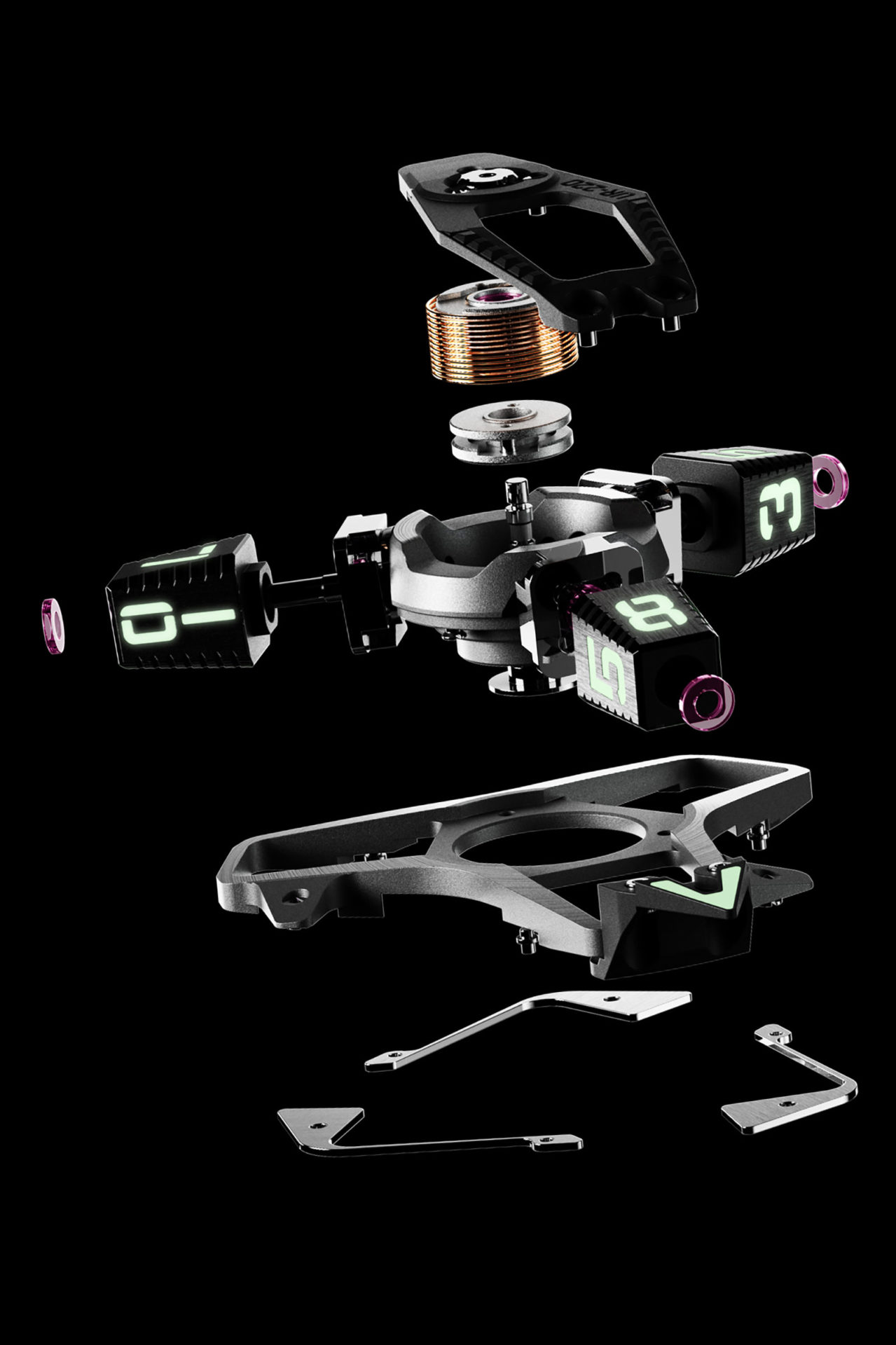
An exploded view of the satellite-cube hours and retrograde minute displays – the cubes rely on vertically-position Maltese crosses to turn while the retrograde hand uses a large, cylindrical spring
The display has been retained essentially unchanged, with the primary tweaks being the twin power reserve indicators. Located at one and 11 o’clock, the indicators each cover half the 48 hour power reserve; note that it’s a separated mechanical display for on a single barrel, and not a twin-barrel movement.
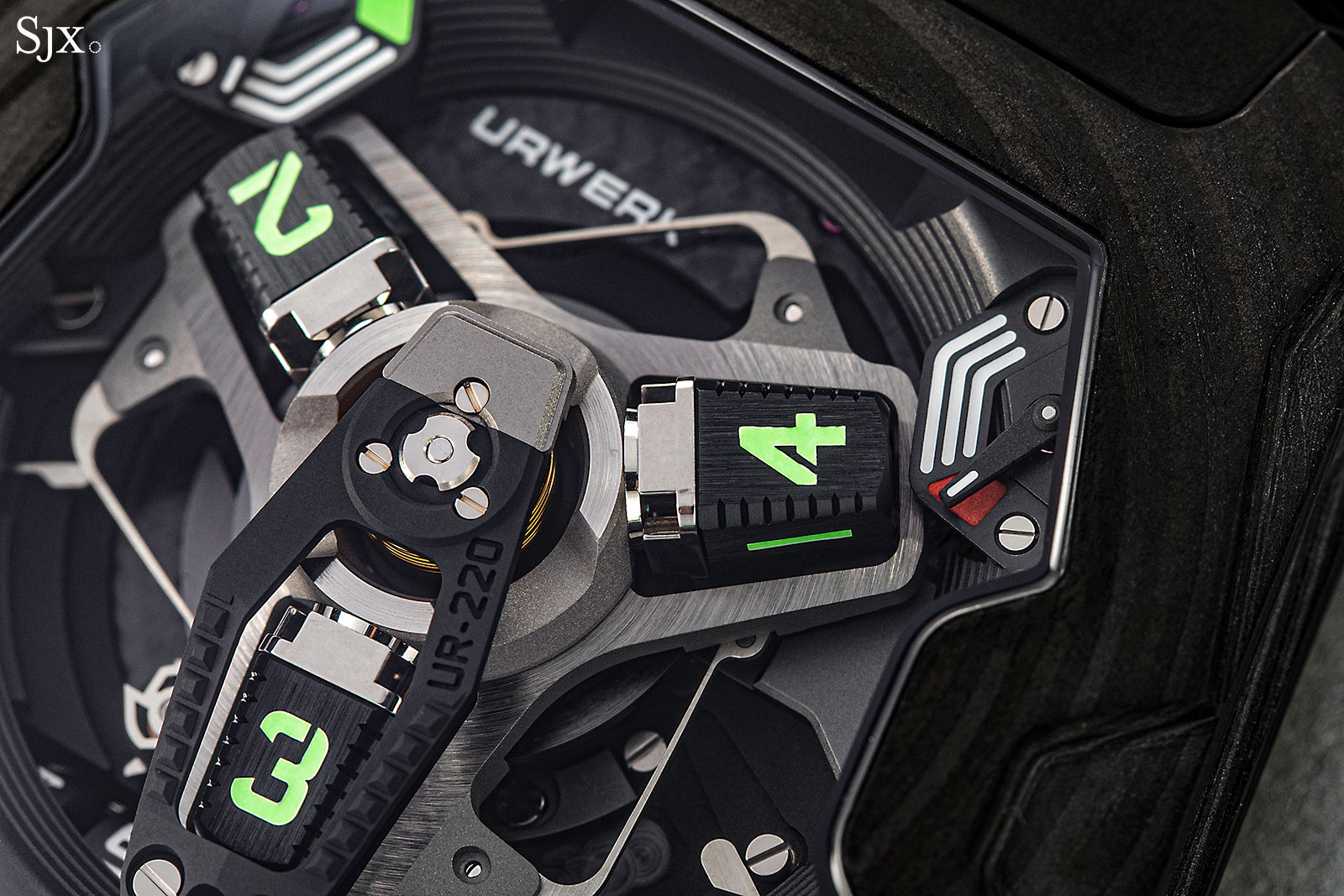
The power reserve indicator for the first 24 hours of running time
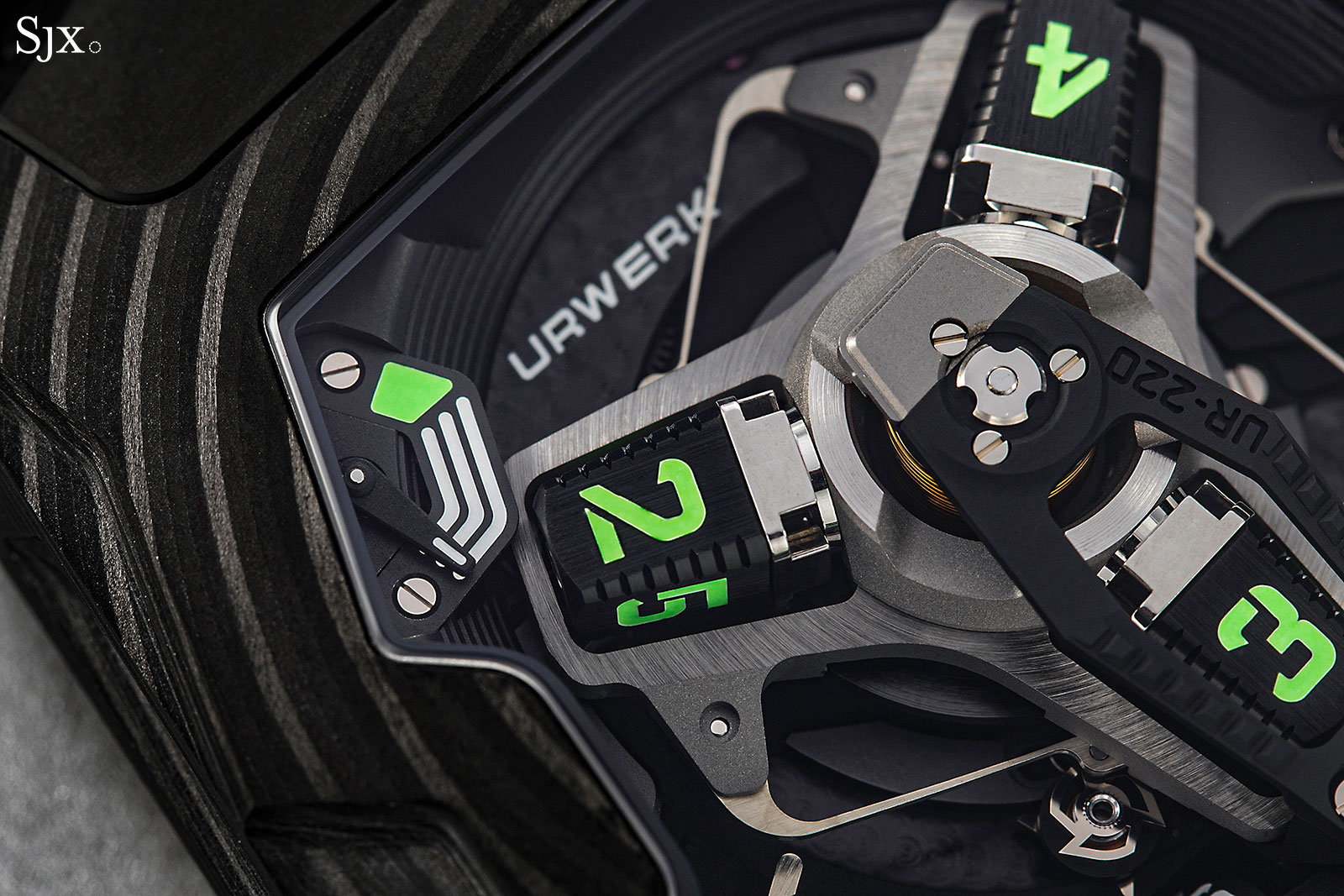
And for the second 24 hours
In contrast the UR-210 had a single power-reserve display plus a winding efficiency indicator, which basically showed how much winding was being done in the last two hours of wear (which is also an approximation of much the wearer was moving). That was more interesting than a power reserve indicator, but only relevant when matched with an automatic movement, which the UR-210 had. The UR-220 is manual wind, making an efficiency indicator meaningless.
Urwerk says the split power-reserve indicator is complicated, requiring some 83 parts, which is no doubt true, but it does seem less compelling than the winding efficiency indicator. Something marginally useful but exotic, like a thermometer, would have been more interesting.
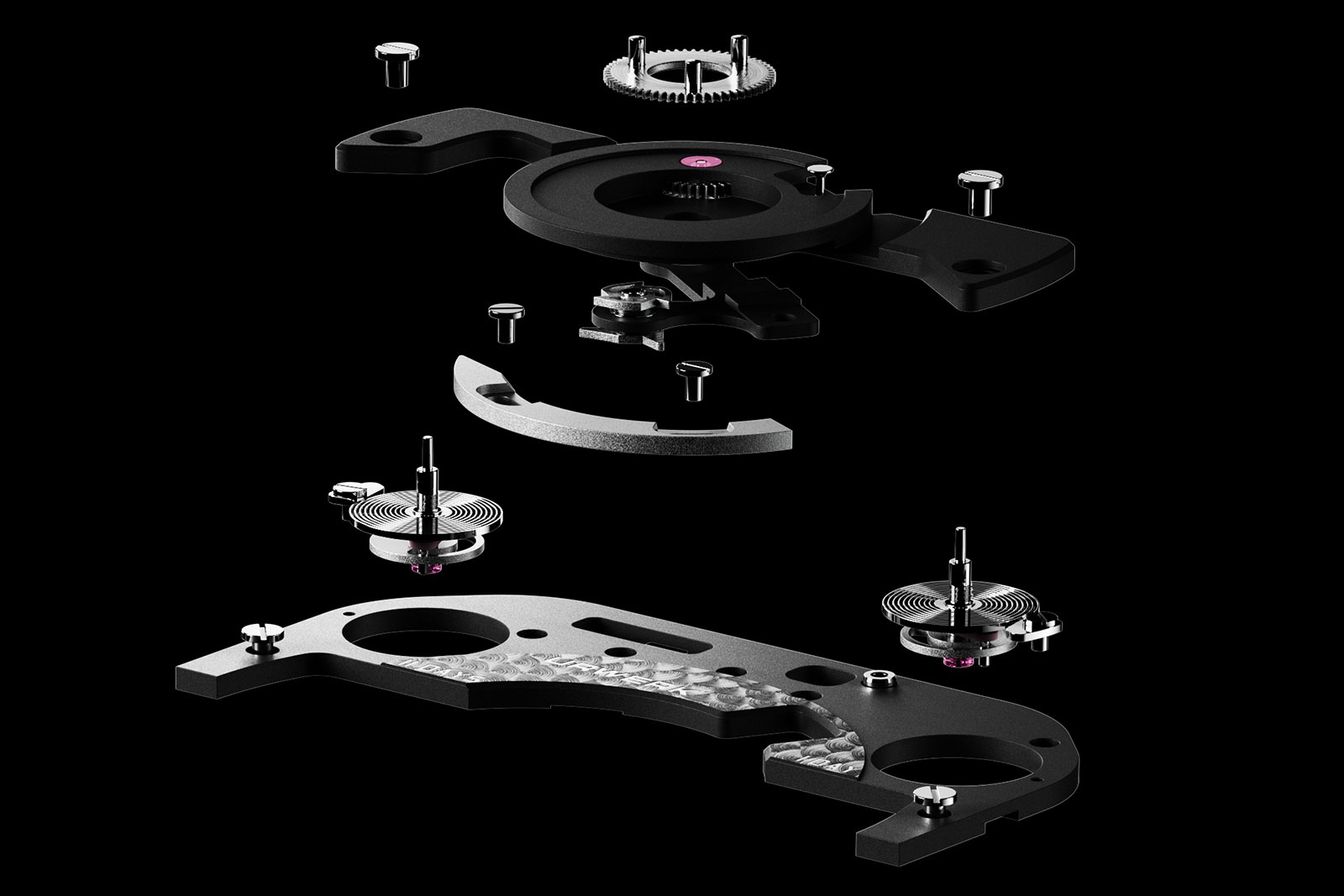
The twin power reserve displays, with a tiny spring for each indicator. Image – Urwerk
While the UR-220 loses an interesting display – necessarily but sadly – it does gain new typography for the numerals on the dial. Although seemingly trivial, the new font is a useful addition, perhaps because there are so many numerals on the dial. The stencil-style font has a sci-fi military look that works well with the watch. One could imagine an olive-camouflage version of the UR-220 being a perfect space-marine instrument.
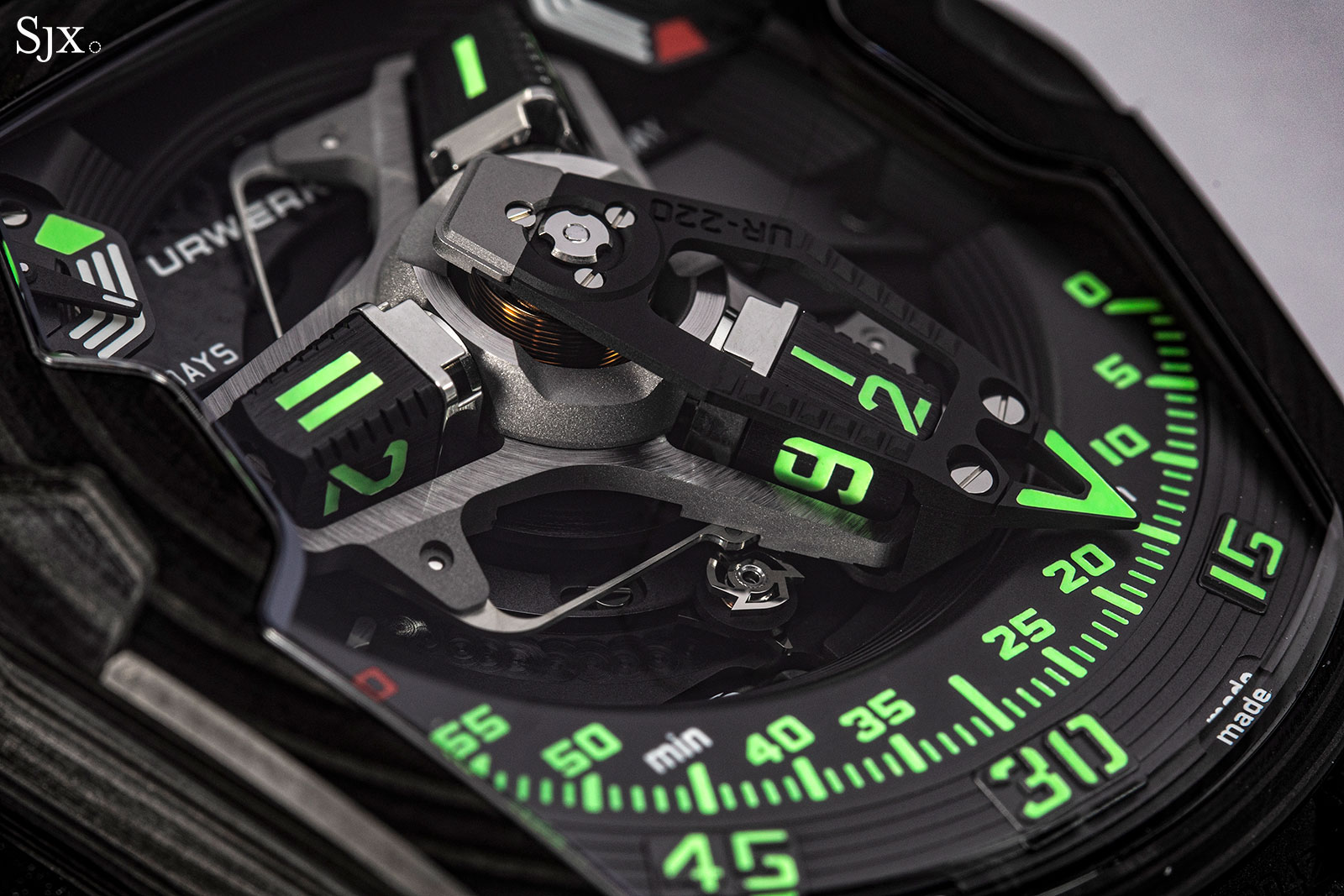
The “instrument panel” back reveals the key new feature of the watch – an “oil change” display that is actually a running-time indicator.
When delivered fresh from the factory, the running-time indicator is immobilised by a pin. Once the owner pulls out the pin – which cannot be replaced except by a watchmaker – the running-time indicator starts rolling. Two cylinders count how long the movement has been running, and they stop at 39 months, which is three years and three months. At that point, a service is recommended.
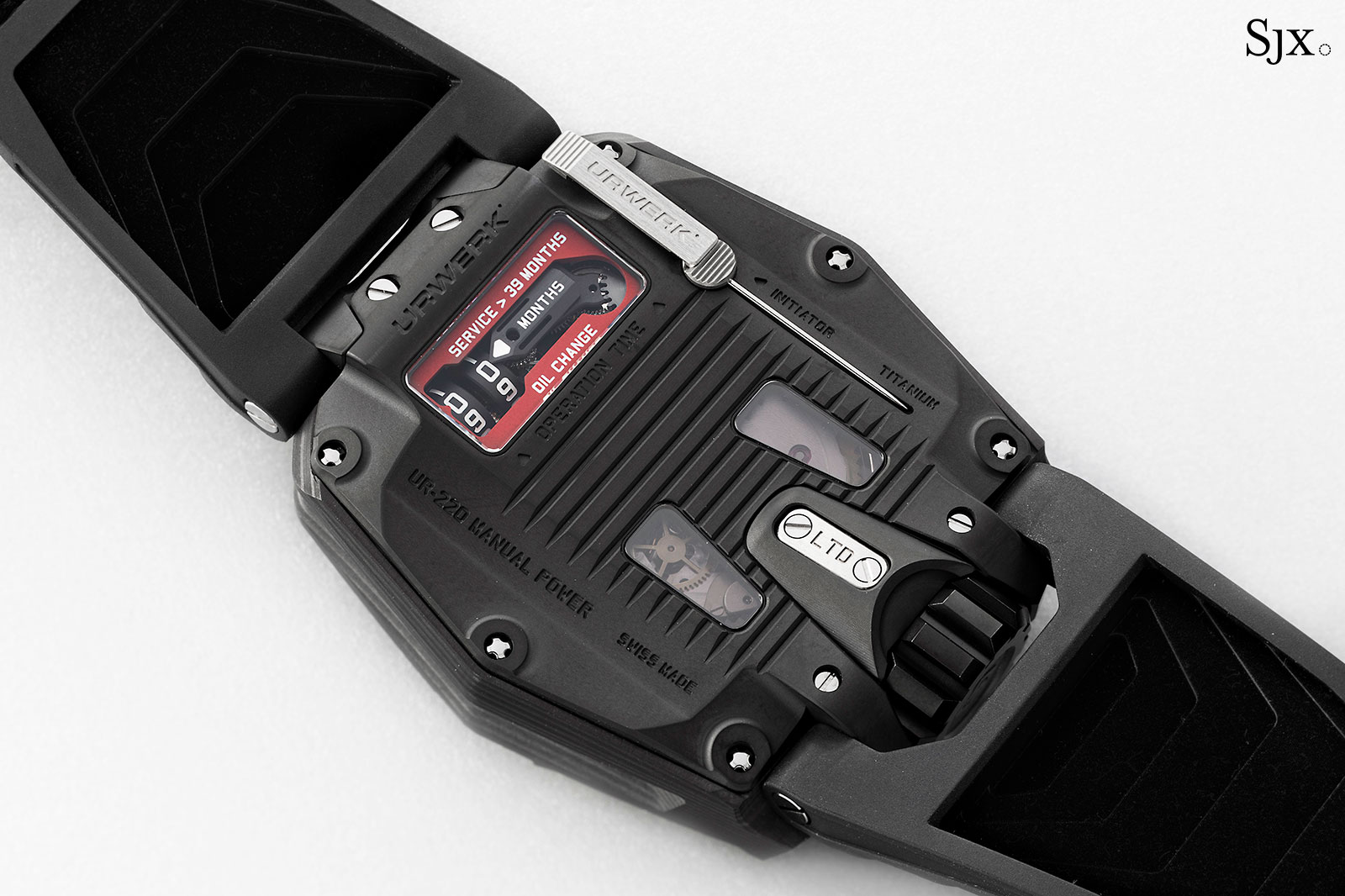
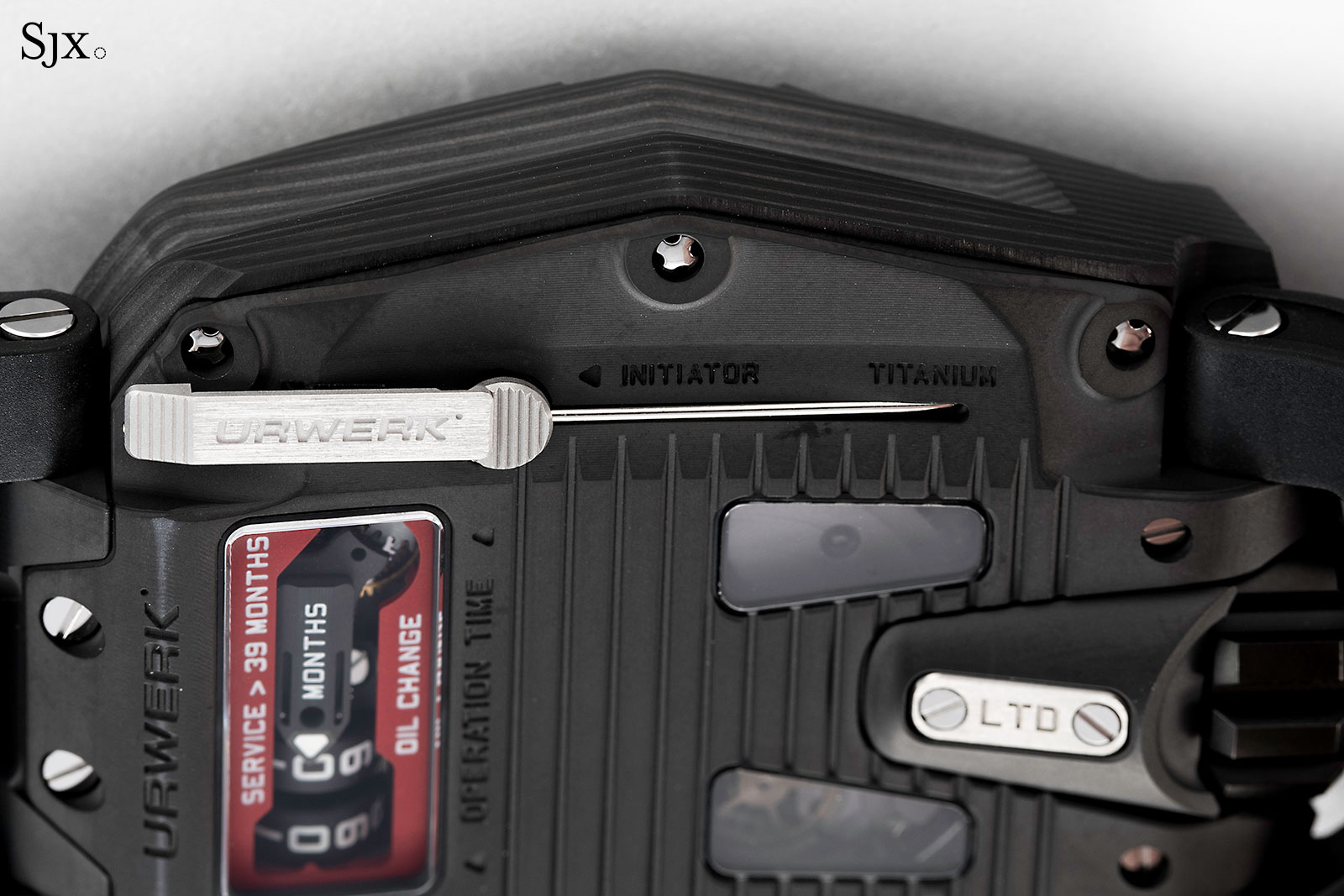
A new UR-220 with the pin in place
I initially thought 39 months too short for a service interval. And then I realised that most owners of the UR-220 probably own several watches, so it will probably take a decade at least to reach 39 months of running time, which makes the indicator relatively sensible.
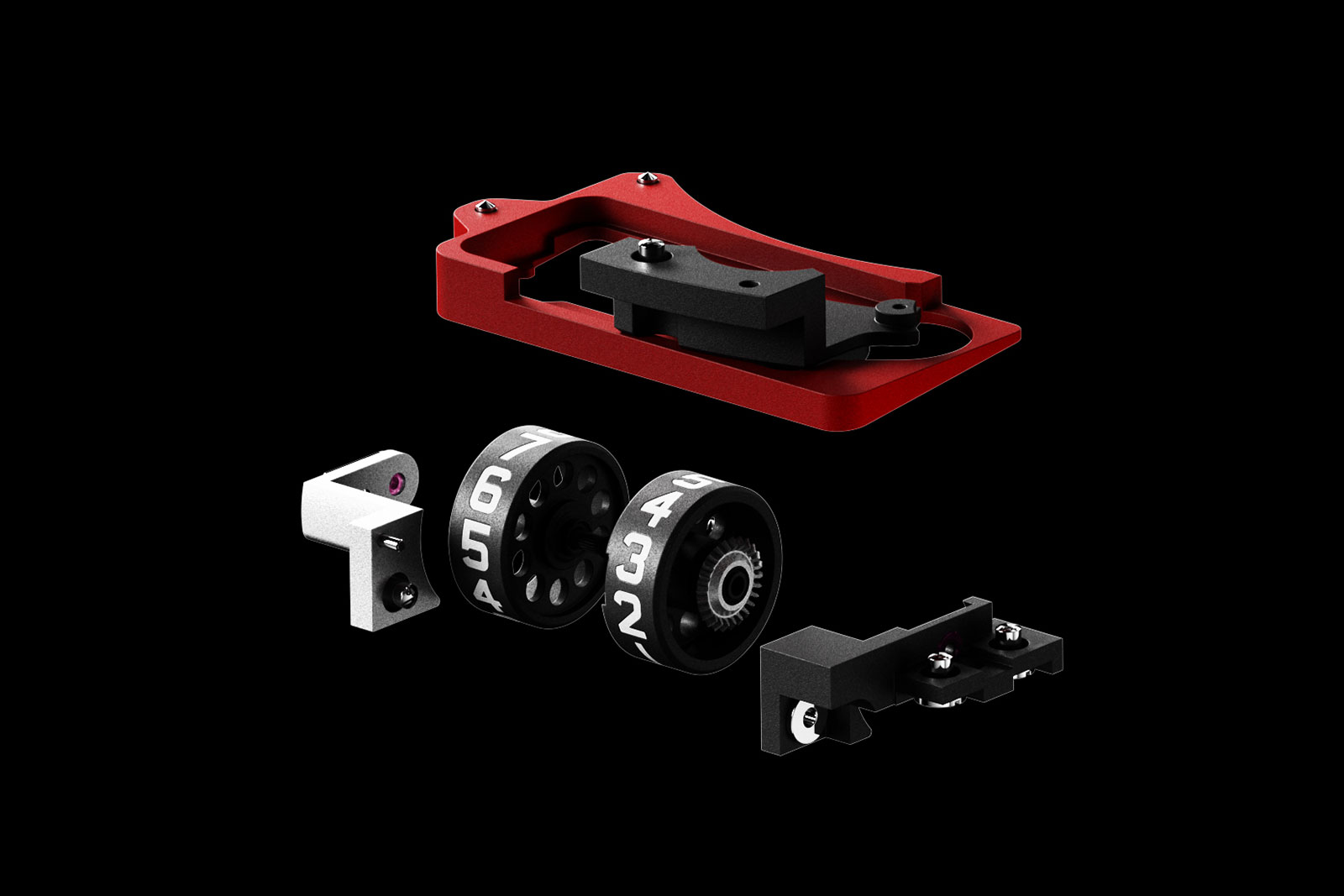
An exploded view of the running-time indicator. Image – Urwerk

Carbon composite case
The carbon-composite case of the UR-220 is a first for Urwerk. While the brand has historically been adventurous in its case coatings, having used steel or platinum cases with various wear-resistant coatings ranging in colour from black to brown to gold, it has always stuck to metal alloys.
The composite is made up of 81 sheets of thinner-than-usual carbon, resulting in a finer grain than most carbon composites used for watch cases. And the carbon sheets are also arranged neatly within the resin, explaining the concentric grain.
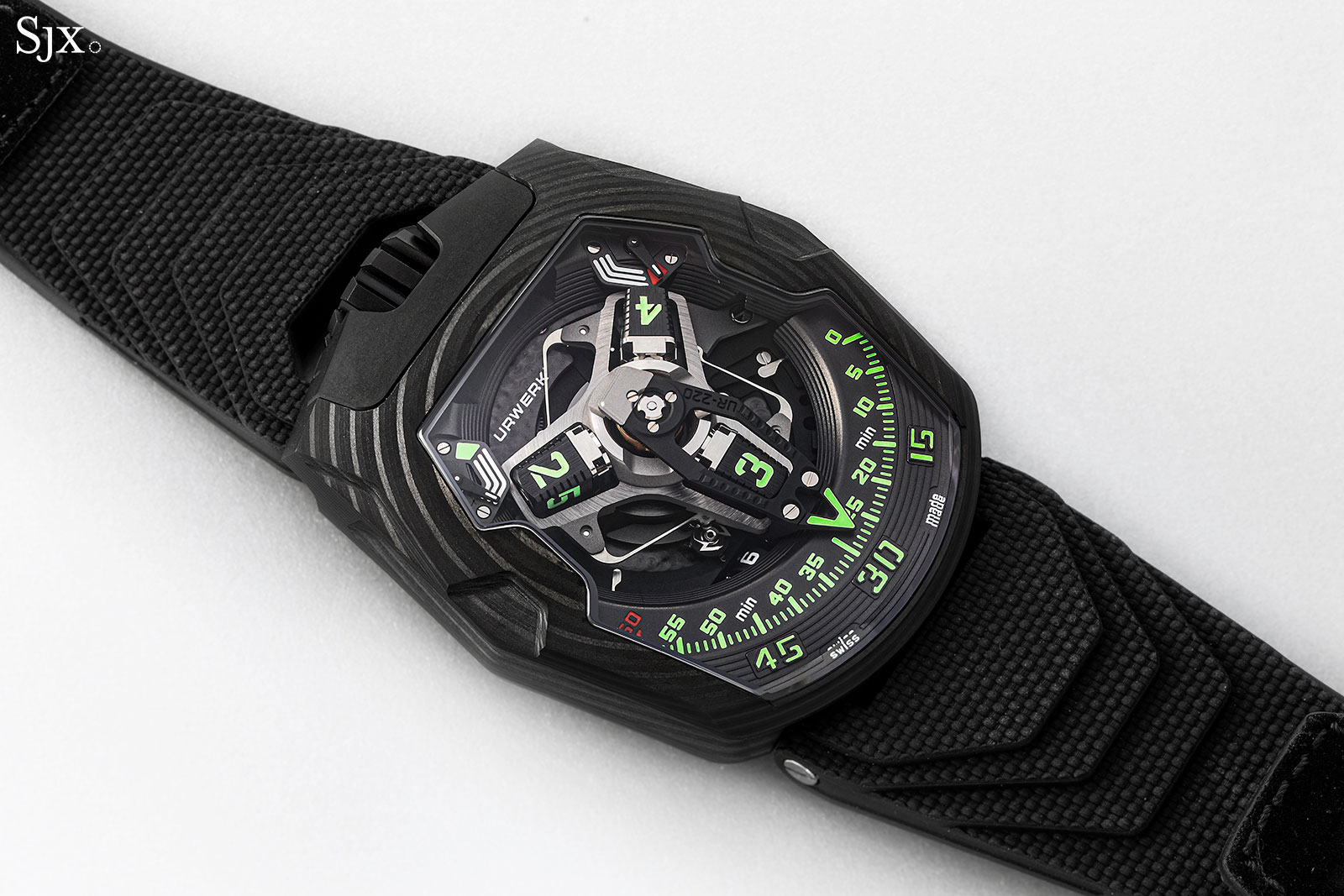
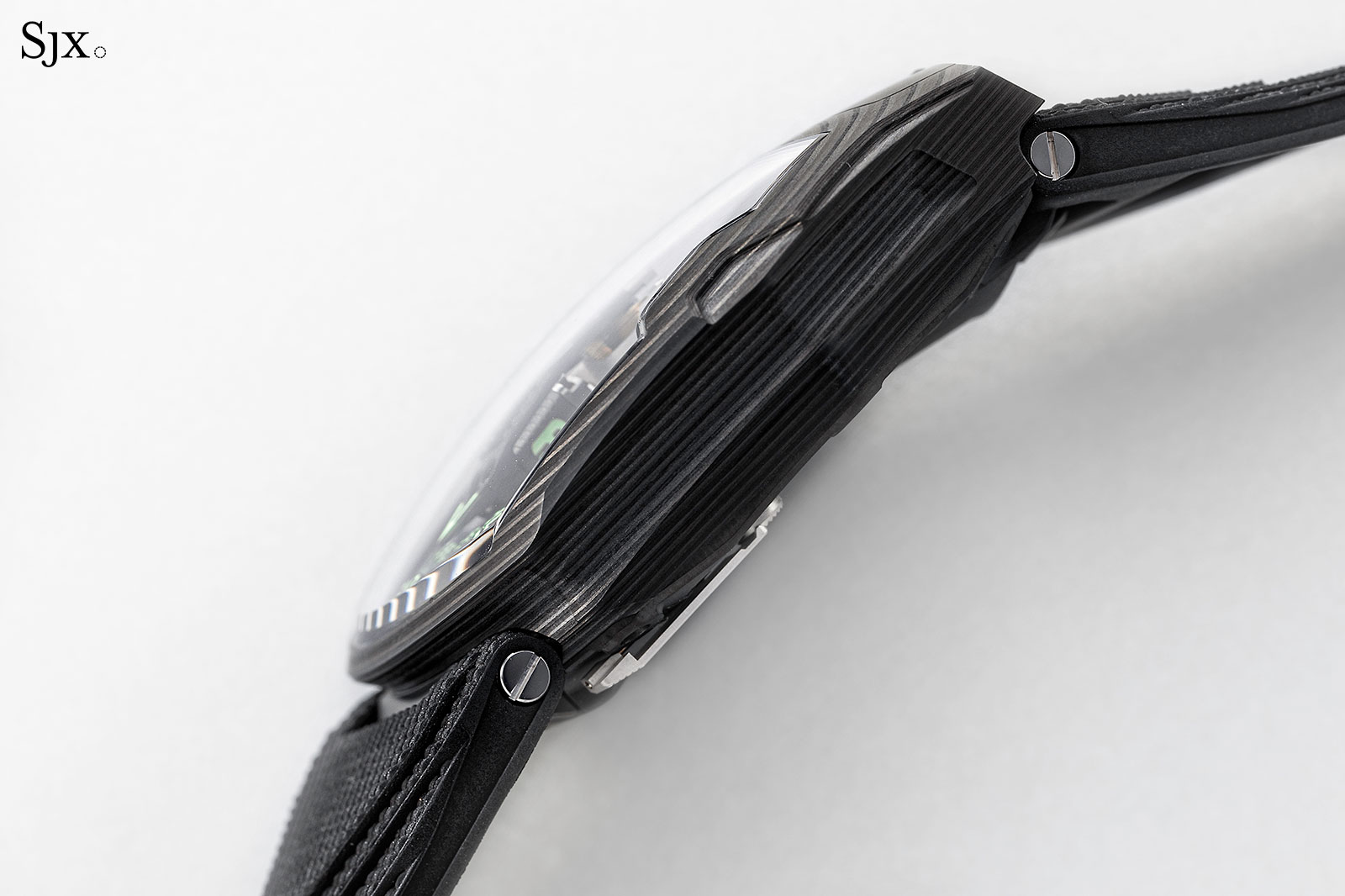
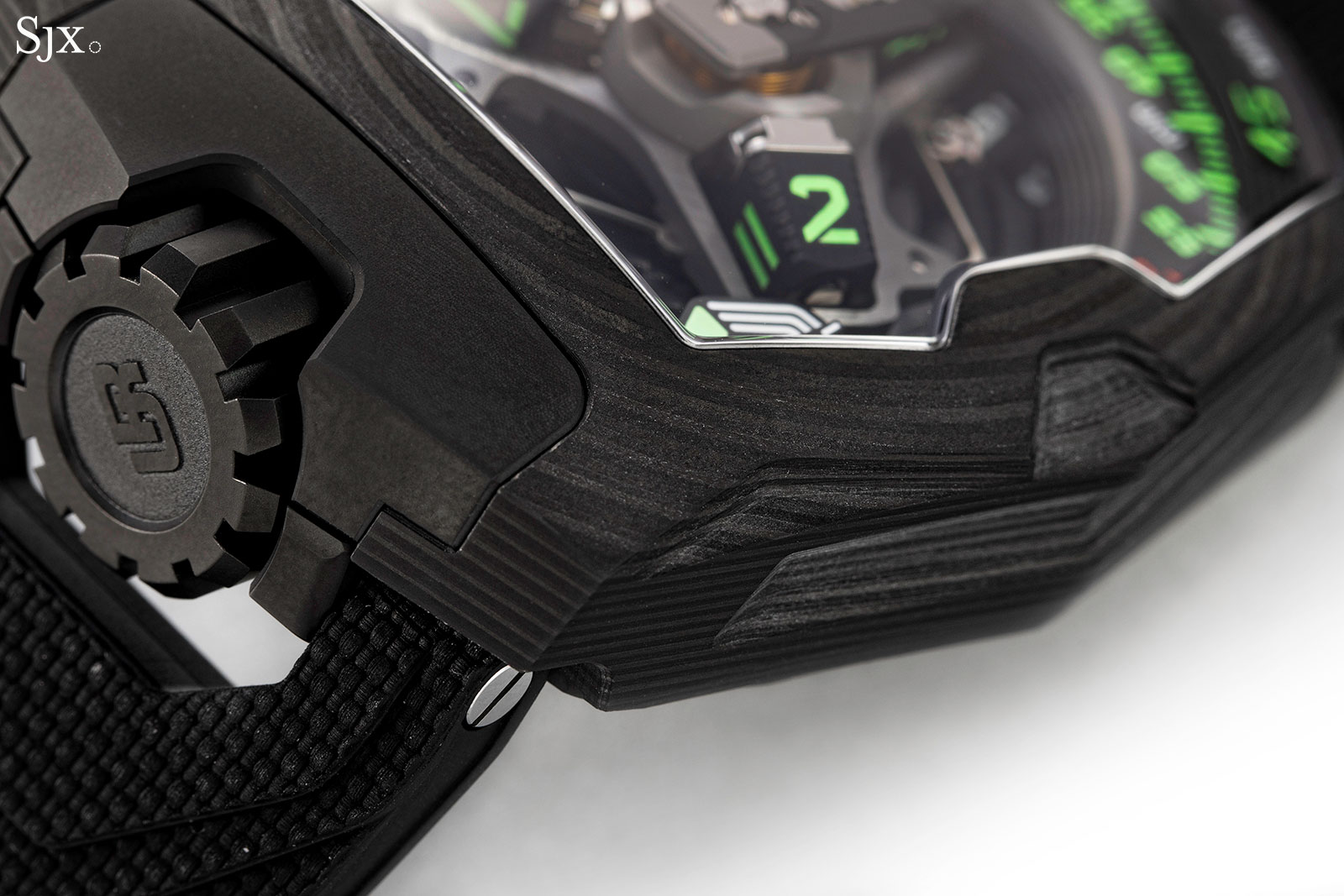
The case back and crown guards are black-coated titanium
Interestingly, the carbon-composite case echos the look of the UR-210 Royal Hawk of 2018. Its case was engraved with a relief, radial pattern, but exceptionally heavy, being platinum coated with black diamond-like carbon (DLC), perhaps an inside joke of sorts for Urwerk.
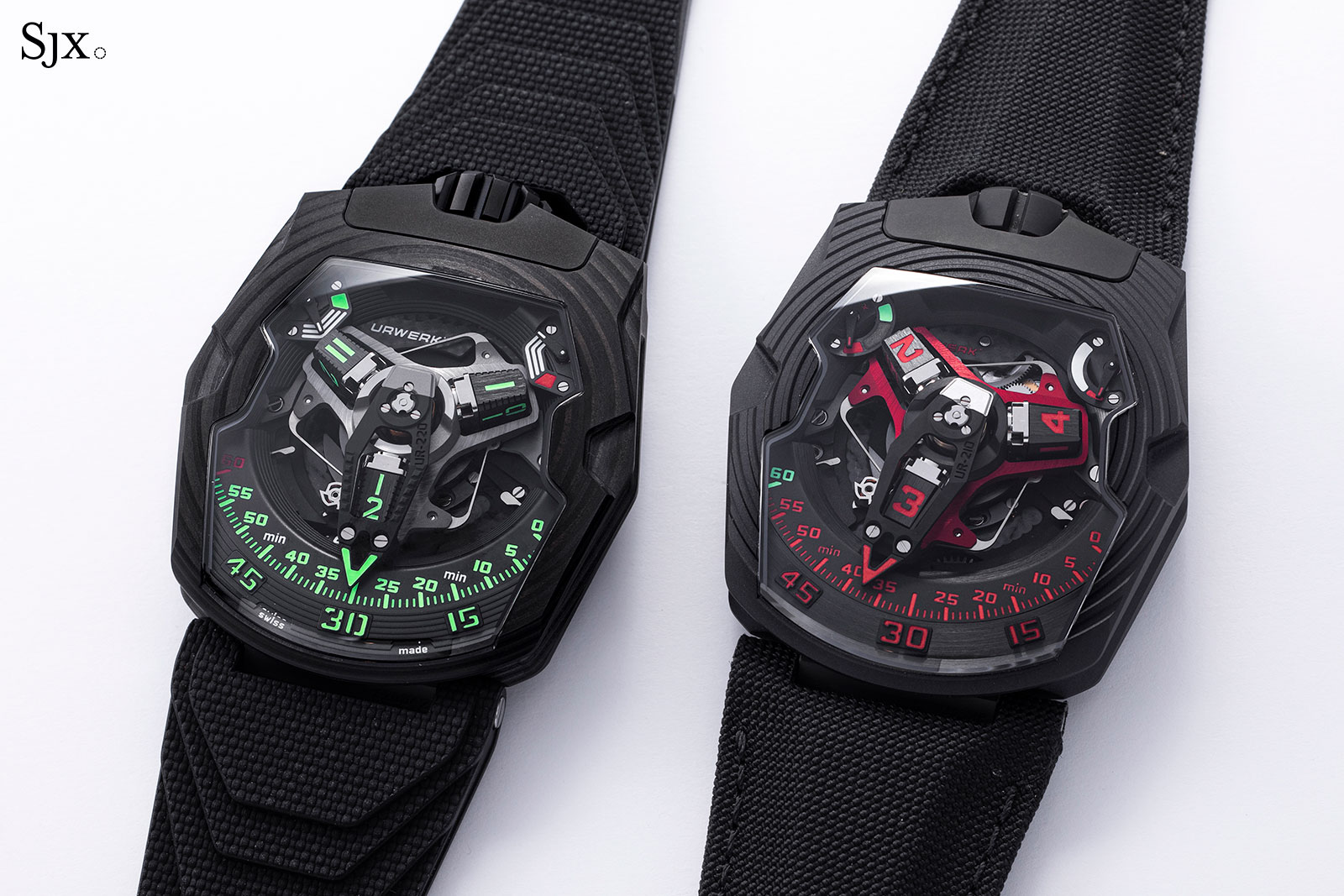
Details
It’s worth mentioning that Urwerk watches are impressive in terms of fit and finish. Not artisanal decorative finishing, but precise and rigorous machining. And that quality has steadily risen over the years, reaching an outstanding level in the UR-220.
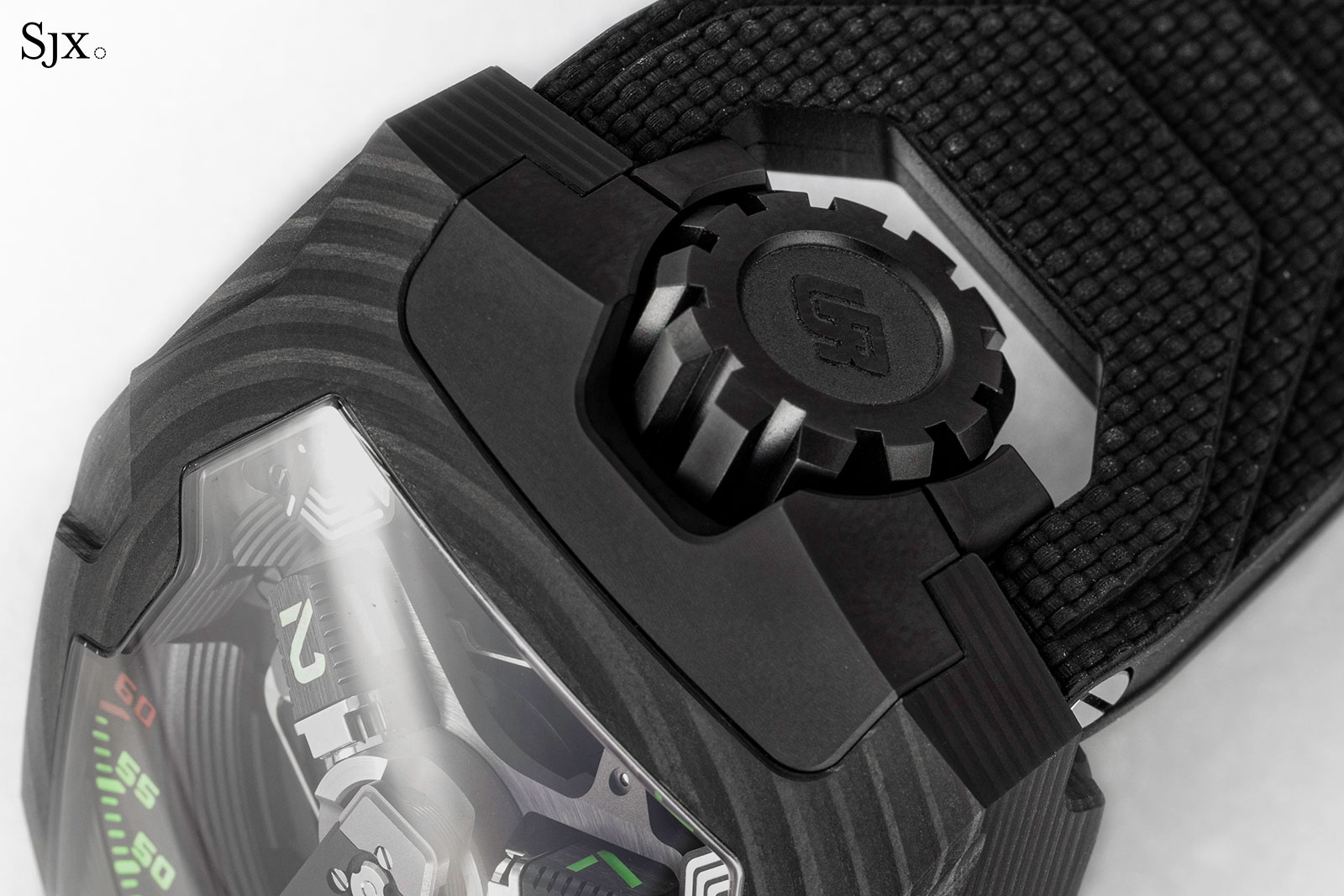
The trademark oversized crown with its bevelled edges and countersunk top
The inside of the watch is equally excellent in detail and finish. The flange of the dial and minute scale, for instance, have finely-engraved concentric rings that echo the grain of the carbon-composite case.
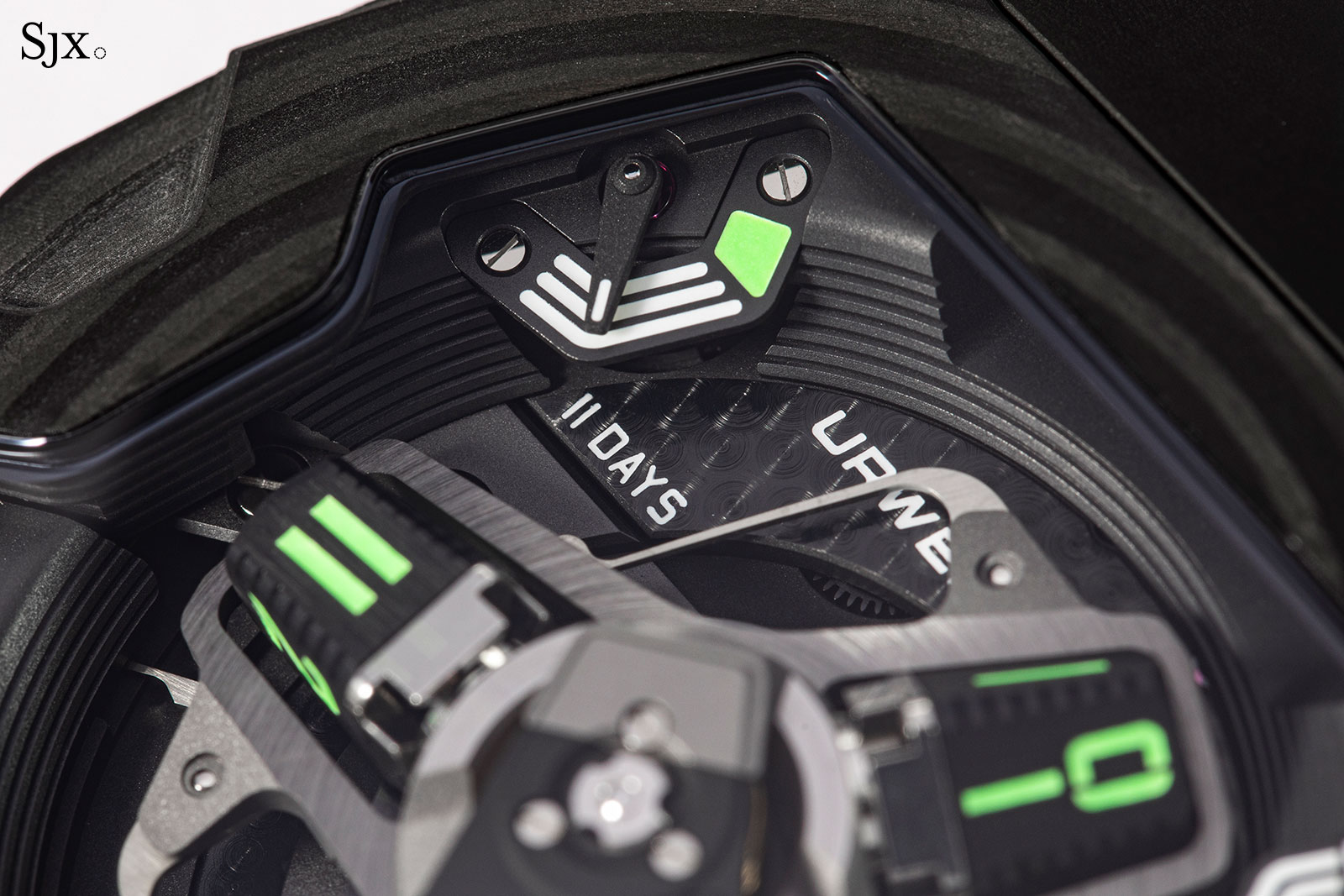
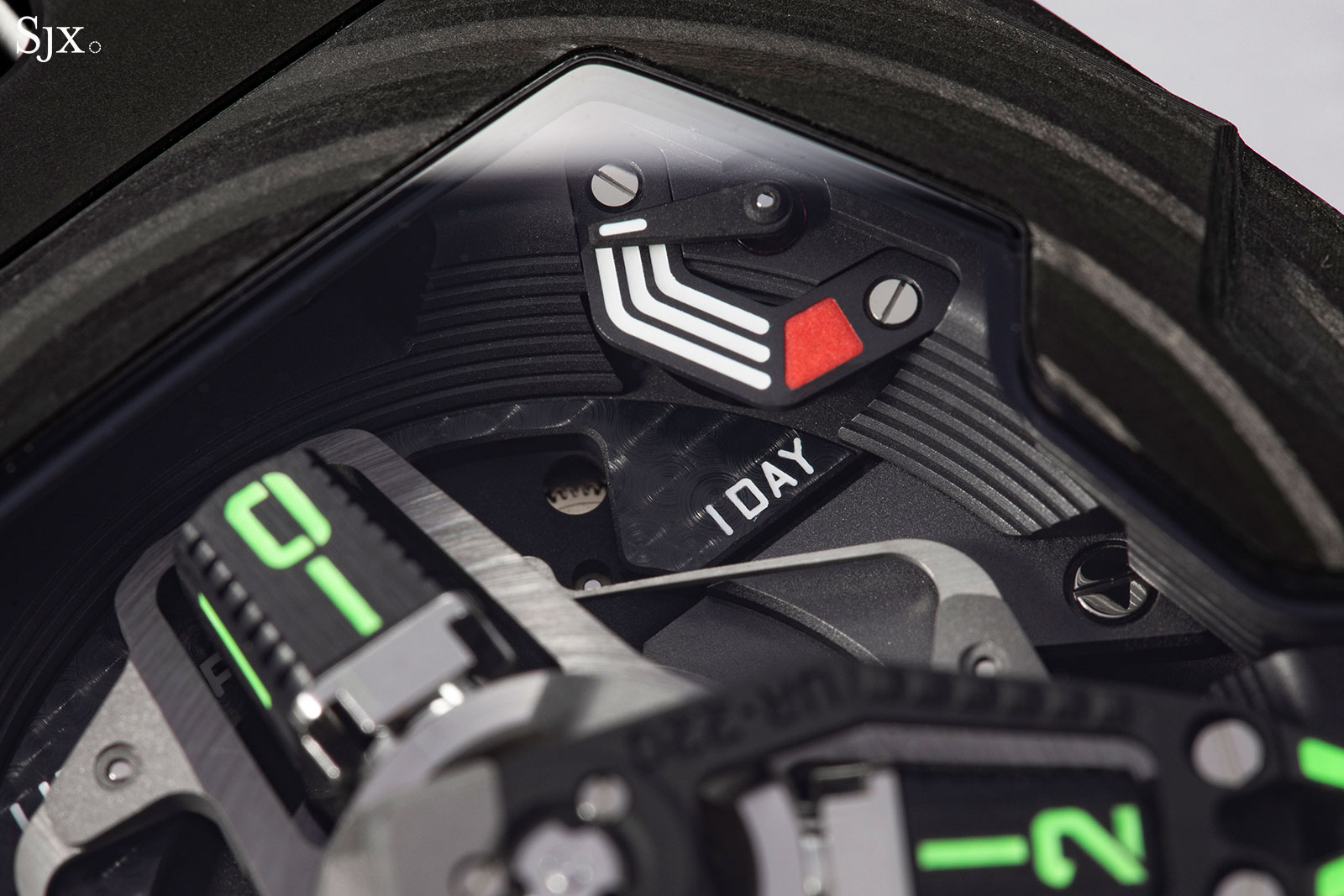
The main plate is finished with tightly-spaced perlage that is deeply polished

All of the parts of the carousel for the satellite-cube display are sharply finished
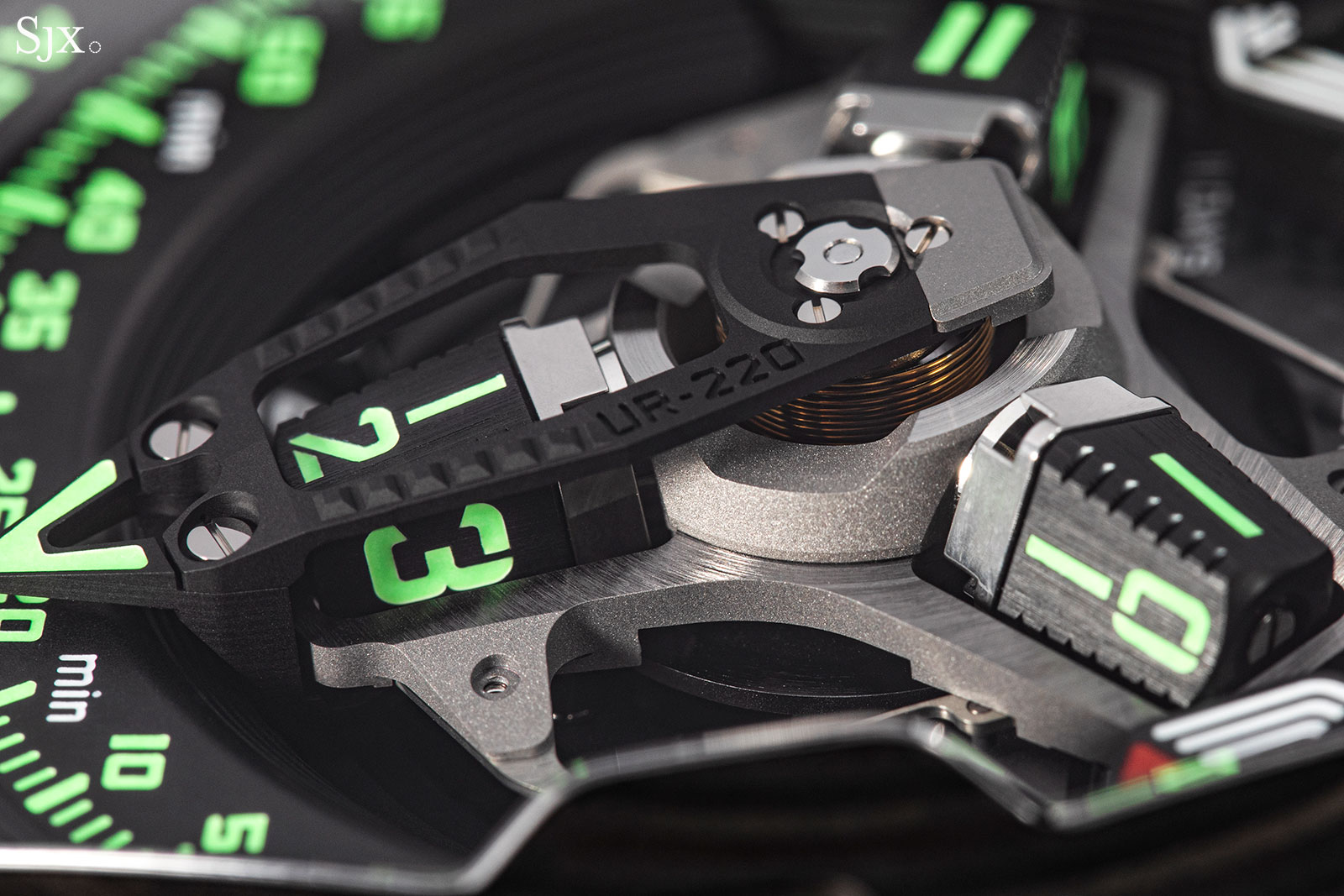
The surface finishing includes frosting, circular graining, and DLC treatment
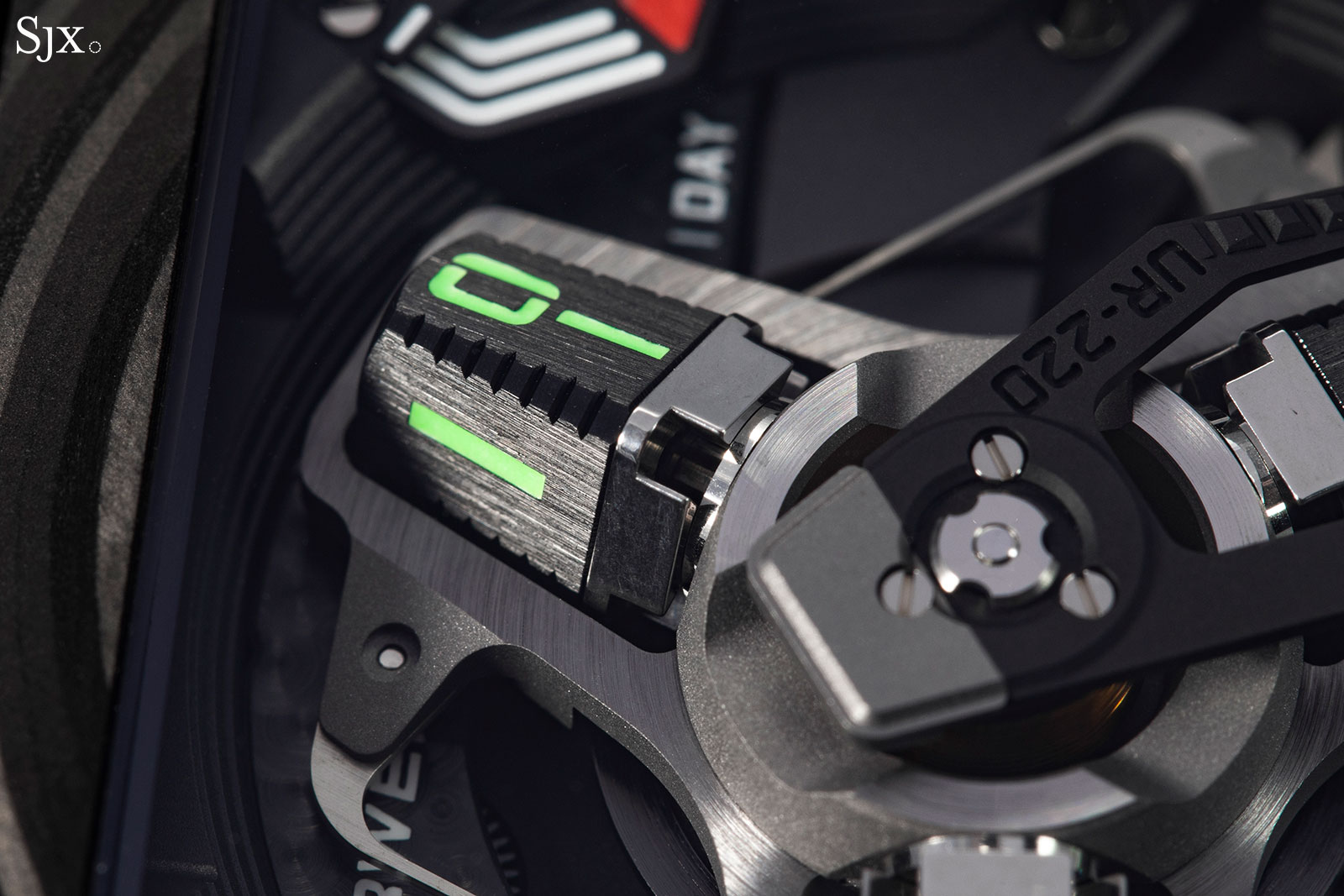
The cubes for the hours are surprisingly detailed, with brushed facts and bevelled edges featuring lateral notches
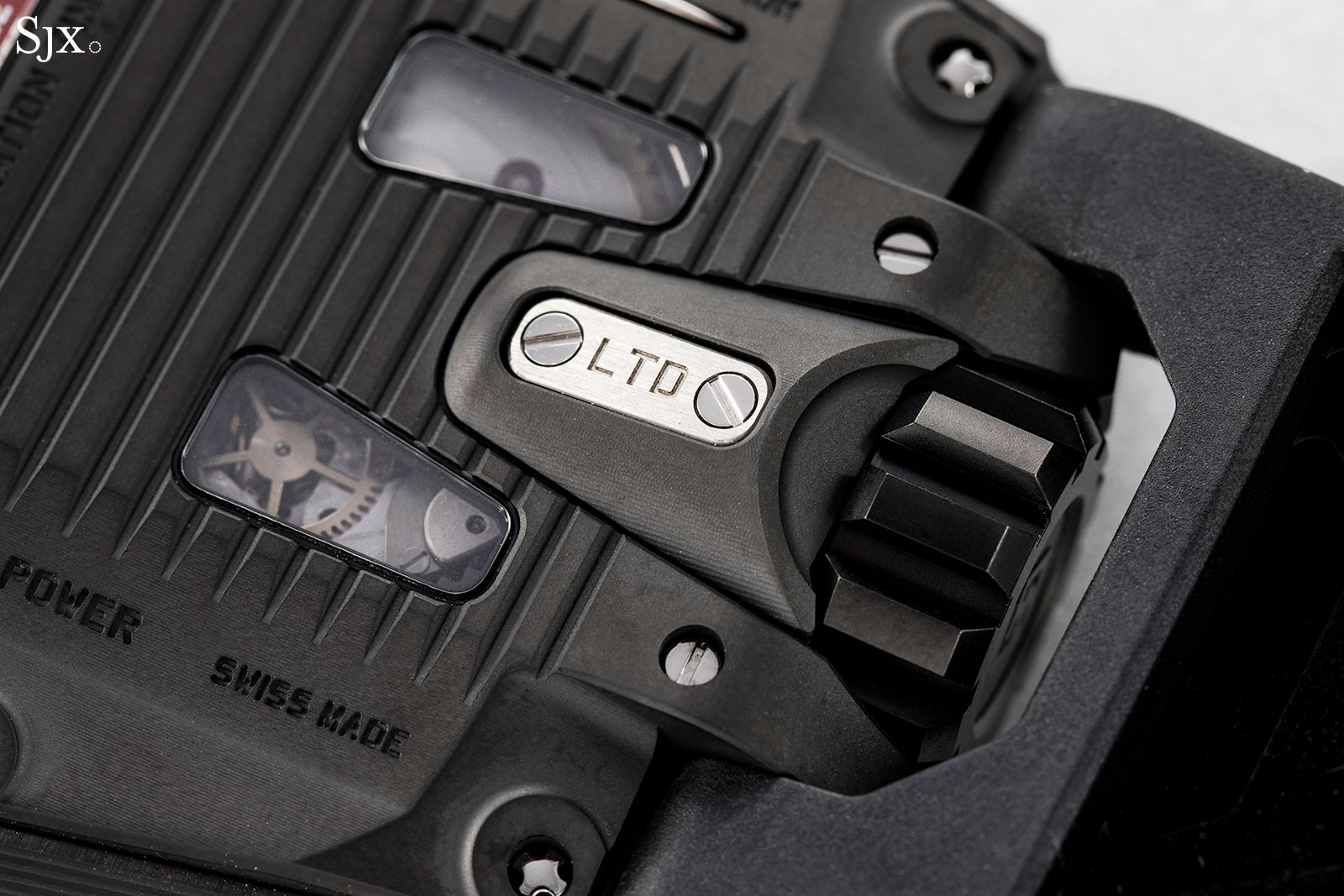
The precision milling is also evident on the case back, which has a good degree of detail, despite being monochromatic
Concluding thoughts
Put simply, the UR-220 is a new and improved version of Urwerk’s most important complication. For anyone who doesn’t have an Urwerk satellite-cube wristwatch, the UR-220 is the ultimate iteration of the satellite-cube concept from a technical and practical perspective. For anyone who doesn’t own an example of the complication, this is it. But for an owner of the UR-210, however, it isn’t quite different enough.
Key facts and price
Urwerk UR-220 “Falcon Project” Carbon Edition
Case diameter: 43.8 mm by 53.6 mm
Case height: 14.8 mm
Material: Carbon composite CTP with titanium case back
Water resistance: 30 m
Movement: UR-7.20
Features: Satellite cube hours and retrograde minutes; double power-reserve displays; and “oil change” indicator
Frequency: 28,800 beats per hour (4 Hz)
Winding: Hand-wind
Power reserve: 48 hours
Strap: Rubber with Velcro fastener
Availability: Already at Urwerk retailers
Price: 145,000 Swiss francs; or 223,200 Singapore dollars
For more, visit Urwerk.com.
Back to top.